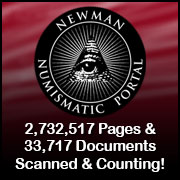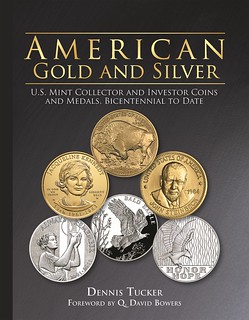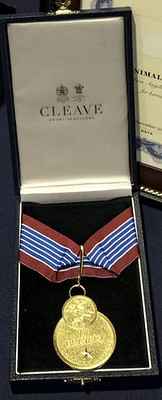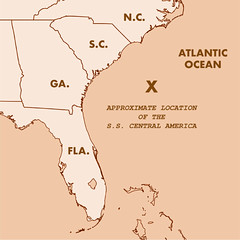
About UsThe Numismatic Bibliomania Society is a non-profit association devoted to the study and enjoyment of numismatic literature. For more information please see our web site at coinbooks.org SubscriptionsThose wishing to become new E-Sylum subscribers (or wishing to Unsubscribe) can go to the following web page link MembershipThere is a membership application available on the web site Membership Application To join, print the application and return it with your check to the address printed on the application. Print/Digital membership is $40 to addresses in the U.S., and $60 elsewhere. A digital-only membership is available for $25. For those without web access, write to: Charles Heck, Treasurer
AsylumFor Asylum mailing address changes and other membership questions, contact Chuck at this email address: treasurer@coinbooks.org SubmissionsTo submit items for publication in The E-Sylum, write to the Editor at this address: whomren@gmail.com BUY THE BOOK BEFORE THE COINSale Calendar
|
- WAYNE'S WORDS: THE E-SYLUM NOVEMBER 17, 2019
- ASYLUM WINTER 2019 ISSUE PUBLISHED
- NEW BOOK: THE SCHER COLLECTION
- NEW BOOK: MONEY ART
- WRITING LOST AND FOUND COIN HOARDS
- WHO DO YOU THANK IN A NUMISMATIC BOOK?
- THE MINT MASTER ON NEWMAN PORTAL
- VIDEO: VICTOR URBANO INTERVIEW
- PERATROVICH DOLLAR RELEASE LOBBIED IN ALASKA
- NOTES FROM E-SYLUM READERS: NOVEMBER 17, 2019
- VOCABULARY TERMS: GOLDPLATE, GOLDPLATING, PART 2
- JOHN C. LIGHTHOUSE (1844-1909)
- HARVEY STACK'S NUMISMATIC FAMILY, PART 57
- 2019 SALTUS AWARD TO MASHIKO
- EXHIBIT: NOTGELD AT THE BRITISH MUSEUM
- A THEFT AT THE ROYAL COIN CABINET
- NUMISMATIC AUCTIONS LLC SALE 64 SELECTIONS
- ARCHIVES INTERNATIONAL SALE 56 SELECTIONS
- WAYNE'S NUMISMATIC DIARY: NOVEMBER 17, 2019
- MET PUTS RARE COINS FROM NISHAPUR ONLINE
- THE LIBERIA DOE COIN
- FANTASY TOKEN DIES EMERGE
- THE SUNOCO ANTIQUE CAR COIN COLLECTION
- THE ATLANTIC CABLE MEDAL OF 1866
- ANIMALS MEDAL OF BRAVERY CREATED
- ROYAL ENGINEERS MUSEUM DISPLAYS VICTORIA CROSS
- HOW THE NOBEL MEDALS ARE MADE
- EMPEROR NORTON 50 CENT BOND DISCOVERED
- OLD GRADING HOLDER COLLECTION SURFACES
- PALESTINE MANDATE BANKNOTES IN THIN SILVER
- LOOSE CHANGE: NOVEMBER 17, 2019
- FEATURED WEB PAGE: MILITARY MEDALS OF AMERICA
Click here to access the complete archive
Click here to unsubscribe (scroll down)
To comment or submit articles, reply to whomren@gmail.com
Content presented in The E-Sylum is not necessarily researched or independently fact-checked, and views expressed do not necessarily represent those of the Numismatic Bibliomania Society.
WAYNE'S WORDS: THE E-SYLUM NOVEMBER 17, 2019
 New subscribers this week include: Jack Evans, courtesy of James Evans; Xander Leijen and Eduard Absil of Schulman b.v,; and Gary Oddie. Welcome aboard! We now have
6,008 subscribers.
New subscribers this week include: Jack Evans, courtesy of James Evans; Xander Leijen and Eduard Absil of Schulman b.v,; and Gary Oddie. Welcome aboard! We now have
6,008 subscribers.
Thank you for reading The E-Sylum. If you enjoy it, please send me the email addresses of friends you think may enjoy it as well and I'll send them a subscription (but let me know if they are located in the European Union). Contact me at whomren@gmail.com anytime regarding your subscription, or questions, comments or suggestions about our content.
This week we open with a new issue of our print journal, two new books, two articles on writing numismatic books, and updates from the Newman Numismatic Portal.
Other topics this week include the Peratrovich dollar, goldplating, collector John C. Lighthouse, dealer Henry Cook, the 2019 Saltus award, notgeld, coin thieves, selections from two upcoming auctions, my numismatic diary from this week's Baltimore coin show, fantasy token dies, the Sunoco Antique car coins, how the Nobel medals are made, reverse electroplating, and the discovery of a rare Emperor Norton note.
To learn more about Mashiko, the Nate S. Shapiro Collection, the literature of Greek banknotes, the Scher Collection of commemorative medals, bulk coin purchases, rare coins from Nishapur, the Atlantic Telegraph Cable medal, the Animals Medal of Bravery, fish money, round hole cash coins, the farting coppersmith, Emperor Norton's Boozeland and the Curse of the Ship of Gold, read on. Have a great week, everyone!
Wayne Homren
Editor, The E-Sylum
ASYLUM WINTER 2019 ISSUE PUBLISHED
Editor Maria Fanning reports that the latest issue of our print journal The Asylum is on the way to the mailboxes of Numismatic Bibliomania Society members. Here is the table of contents and a message from our President Tom Harrison. Another great lineup of articles! -Editor
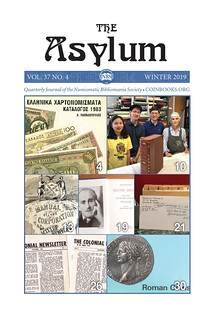 The Asylum
The Asylum
Winter 2019
Volume 37 No. 4
Table of Contents:
• A Complete List of the Literature for Greek Banknotes By Evangelos Fysikas
• A Journey to the Bindery By Kingsley Hong
• A Newly-Described Printing of Charles Ira Bushnell's Early New York Tokens By Joel J. Orosz
• A Life Story and How NOT to Research Numismatists By David Pickup
• A Supplement to "NBS Charter Members" by Pete Smith in the 40th Anniversary Issue of The Asylum By Joel J. Orosz
• From Little Acorns By David Gladfelter
• How to Collect: Roman Coin Books By David Pickup
Message from President Tom Harrison
I am delighted to announce the NBS will be debuting their quarterly podcast in the near future. Typically 15 to 30 minutes in length, it will cover an array of topics from book
reviews to interviews with collectors to building and caring for a numismatic library. Lianna Spurrier, who produced the outstanding daily videos at this years ANA Convention,
will be producing the podcast. She has also done work for the Newman Numismatic Portal, C4, CDN and CoinWeek.
Lianna's first interview will be with the esteemed numismatic researcher, author and NBS Historian, Joel J. Orosz, who has built a remarkable antebellum library. Of paramount importance, I believe the podcast will serve our foundational purposes of sharing educational opportunities and introducing collectors to the fascinating world of numismatic literature.
Following this summer's ANA Convention in Rosemont, the issue of providing deeper display cases for numismatic literature exhibits arose. The concern centered on the stress placed on the spines of antiquarian books which require being opened flat in the shallow cases provided by the ANA. Upon inquiry, the ANA stated that due to transportation cost they are attempting to reduce the amount of materials they send to conventions. Even if the NBS was willing to underwrite the cost of deeper cases, space constraints would be problematic for the ANA. It is our hope that NBS members will continue to explore creative ways to exhibit special works from their libraries without compromising the integrity of their books.
May your numismatic library provide investigation, discovery and most of all, enjoyment.
Great news about the podcast!
While The E-Sylum is free to all, only paid members of the Numismatic Bibliomania Society receive our print journal, The Asylum. Print/Digital membership is $40 to addresses in the U.S., and $75 elsewhere. A digital-only membership is available for $25. -Editor
To join NBS or renew your membership, see:, see:
https://www.coinbooks.org/about/membership.html
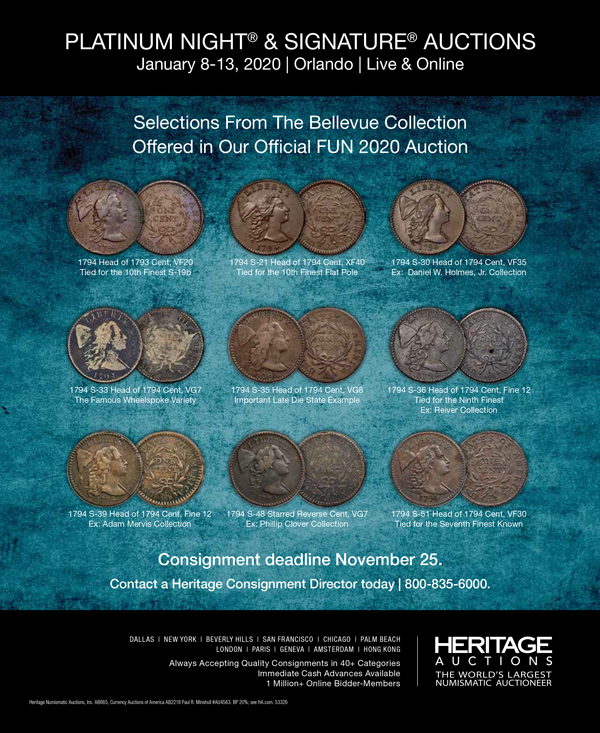
NEW BOOK: THE SCHER COLLECTION
Earlier this year a new book based on the Scher Collection of commemorative medals was published by The Frick Collection. -Editor
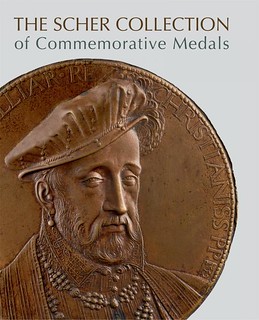 The Stephen K. and Janie Woo Scher Collection, a significant portion of which has gone to The Frick Collection as an initial and promised gift, is considered the world's
greatest private collection of portrait medals, rivaling many collections in international museums. This fully illustrated catalogue documenting the Scher Collection is an
essential resource for scholars, students, collectors, and curators.
The Stephen K. and Janie Woo Scher Collection, a significant portion of which has gone to The Frick Collection as an initial and promised gift, is considered the world's
greatest private collection of portrait medals, rivaling many collections in international museums. This fully illustrated catalogue documenting the Scher Collection is an
essential resource for scholars, students, collectors, and curators.
Portrait medals were developed during the Italian Renaissance and are central to the history of European portraiture, flourishing as an art form through the nineteenth century and into the twentieth century. Though less familiar to us now than painting and sculpture, these exquisitely crafted objects, typically made from lead, bronze, silver, or gold, were produced (sometimes in large numbers) to commemorate individuals, to acknowledge special events, and to disseminate the identity and power of their sitters. The study of the portrait medal has become, through& the work of Stephen Scher and others, a burgeoning area of scholarship. Excellent reproductions of all medals at actual size, with details of obverse, reverse, and full captions, are accompanied by scholarly essays, notable facts, and historical references in this important new volume.
Authors: Edited by Stephen K. Scher with the assistance of Aimee Ng, with essays by Christopher Eimer, Martin Hirsch, Mark Jones, Jan Pelsdonk, Marie-Astrid Pelsdonk, Ulrich Pfisterer, and Stephen K. Scher; entries by Walter Cupperi, Alessandra Di Croce, Arne Flaten, Emma Merkling, Carolyn Miner, Aimee Ng, Marie-Astrid Pelsdonk, and Stephen K. Scher; and artist biographies by Emma Merkling, Stephen K. Scher, and Davide Stefanacci
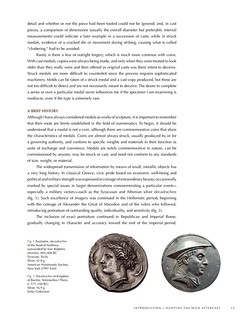
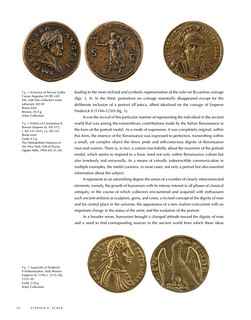
Publisher: The Frick Collection in association with D Giles Limited
Hardcover, 9 x 12 in., 656 pages, 1842 color illustrations
Price:$280.00
Member Price:$252.00
For more information, or to order, see:
The Scher Collection of Commemorative Medals
(https://www.frick.org/shop/art_frick_collection/scher_collection_medals)
The Scher Collection of Commemorative Medals
(https://www.amazon.com/Scher-Collection-Commemorative-Medals/dp/1907804870)
A nice review of the book by David Masello was published October 9, 2019 in Sculpture magazine. Here's an excerpt. -Editor
Sculpture portable enough to fit in the palm of your hand, inside a pocket, or tucked into a wallet can also be invested with enough narrative power to tell an epic story. The newly published catalogue, The Scher Collection of Commemorative Medals, proves that sculpture the size of a silver dollar can assume the presence of something monumental. The first example of such portable power was likely cast around 1438, in Italy. On a roughly four-inch-diameter lead disk, the artist known as Pisanello sculpted a two-sided portrait of a Holy Roman Emperor. Pisanello's work, like all subsequent portrait medals, was both commemorative and sculptural.
Dr. Stephen Scher, the owner of the 884 objects illustrated in actual size in this epically weighted (and priced) volume, admits to being afflicted since childhood with "the collector's disease." During his 60 years amassing portrait medals, he has emerged as the world's most prolific collector of the art form. As any museum director might remark upon receiving a bequest of this scale, Ian Wardropper, director of the Frick Collection, happily writes in the foreword that of this "greatest medal collection in private hands…a significant portion of it has very generously come to the Frick as an initial and promised gift."
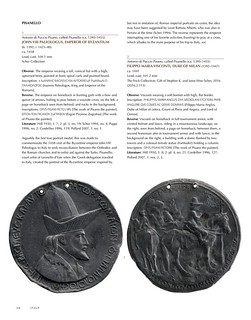
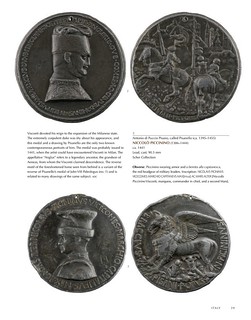
In presenting the case for portrait medals as sculpture, Scher and the other scholars who have contributed to the book come across as slightly defensive but ultimately convincing. "Although I have always considered medals as works of sculpture," Scher writes in his introduction, "it is important to remember that their roots are firmly established in the field of numismatics. A medal is not a coin." He goes on to explain that coins, unlike the treasures he has collected from Italy, Germany, France, England, Scandinavia, Switzerland, Mexico, and the United States, are always "struck," whereby an image is pressed onto and into a blank metal form. Money is issued by a governing agency. While coins "conform to specific weights and materials in their function as units of exchange and commerce," Scher emphasizes, "medals are solely commemorative in nature, can be commissioned by anyone, may be struck or cast, and need not conform to any standards of size, weight, or material."
And just in case the matter of sculpture versus currency is still in doubt, Wardropper adds that "Steve's rigorous scholarship over the years has done much to establish medals—traditionally considered closer to numismatics than to fine art—as small-scale sculptures deserving of a prominent place in the history of art." Once the Scher collection is housed at the Frick, the institution will likely become one of the world's largest repositories of the art form.
To read the complete article, see:
Medals of Honor (https://sculpturemagazine.art/medals-of-honor/)
To read an earlier E-Sylum article about a related exhibit catalog, see:
NEW BOOK: SCHER COLLECTION OF PORTRAIT MEDALS (https://www.coinbooks.org/v20/esylum_v20n30a06.html)
NEW BOOK: MONEY ART
The Geldscheine Online newsletter features an article by Hans-Ludwig Grabowski on a new book about the money art of Matej Gábris. Here's a Google-translated excerpt. -Editor
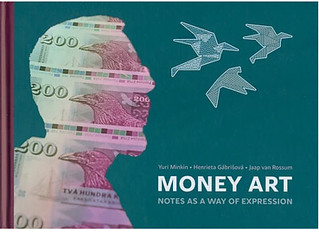 "The book, written entirely in English, presents the banknote creations of the Slovak artist Matej Gábris, who sees himself as a "conceptual music maker".
Impressive is the artistic ingenuity, from which ultimately his fantasy notes emerge. After an introduction that deals with fantasy banknotes in general, the artistic design of
banknotes and security printing, a kind of catalog begins in which all the banknotes projects of the artist are presented. Very clever from the publisher, that the book also as an
encore added a fancy note, the desire to do more. It is a 2019 "Banco di Firenze" 500 lire note, labeled as "no value pattern"."
"The book, written entirely in English, presents the banknote creations of the Slovak artist Matej Gábris, who sees himself as a "conceptual music maker".
Impressive is the artistic ingenuity, from which ultimately his fantasy notes emerge. After an introduction that deals with fantasy banknotes in general, the artistic design of
banknotes and security printing, a kind of catalog begins in which all the banknotes projects of the artist are presented. Very clever from the publisher, that the book also as an
encore added a fancy note, the desire to do more. It is a 2019 "Banco di Firenze" 500 lire note, labeled as "no value pattern"."
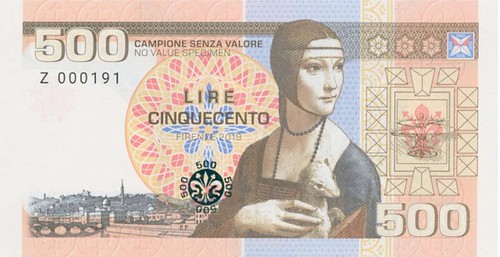
The following is from the publisher's web site. -Editor
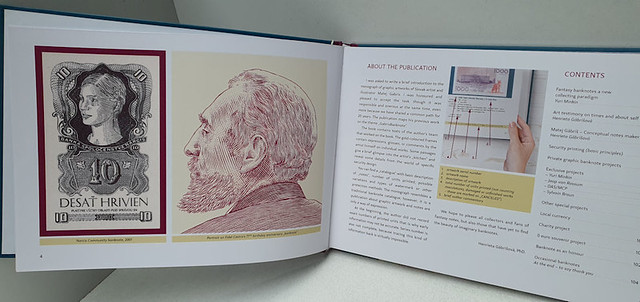
112 Full Color Pages
Included Bonus design Banknote from Italy
MONEY ART
Notes as a way of expression
Cover: Hardcover
Pages: 112 full color pages
Included: Banknote design, Italy 500 Lire Florence from page 75 printed 565 pcs
Graphic Design: Matej Gábris
Project editor: Henrieta Gábrisova
Translation: Peter Kvito, Adam Gábris
Authors: Yuri Minkin, Henriea Gábrisová, Jaap van Rossum
Front: Samo Sans (CarnokyType)
Printed in Slovakia: Typografia plus, s.r.o.
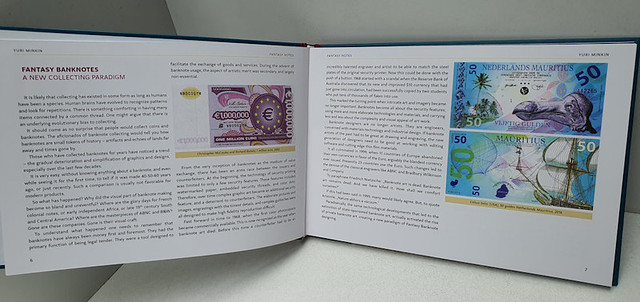
Publisher
Vydavatel'stvo Detail s.r.o.
ISBN 978-80-972519-4-9
EAN 9788097251949
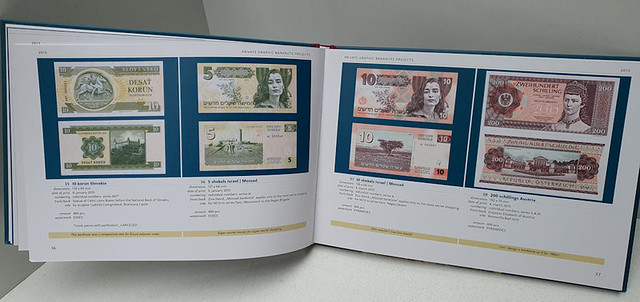
For more information, or to order, see:
https://www.banknote24.eu/contents/en-us/p6203_Catalog-Money-Art-from-Matej-Gabris-2019-2020.html

WRITING LOST AND FOUND COIN HOARDS
Dave Bowers submitted this article via Whitman Publishing about how he came to write his book Lost and Found Coin Hoards and Treasures, now in its second edition. -Editor
Coin Hoards, Treasures, and Troves: Separating Truth From Taradiddles!
by Q. David Bowers
The second edition of Q. David Bowers's Lost and Found Coin Hoards and Treasures, one of the most exciting coin-collecting books of recent years, has been released by Whitman Publishing. The 480-page hardcover book is available online and in bookstores and hobby shops nationwide. Here, Bowers discusses his research and writing.
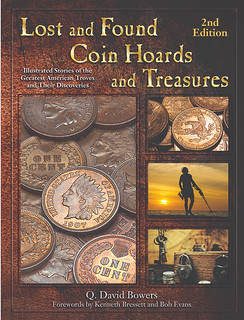 Buried treasure! Gold! Pirates! This is the stuff of which dreams are made. When in the early 1950s I discovered the world's greatest hobby and started building a
numismatic library, I was off to a good start in reading about the lore and lure of treasures. Back issues of the American Journal of Numismatics and The Numismatist
had many stories and news accounts of coins found hidden in the walls of buildings, buried in chests, or recovered from the sea.
Buried treasure! Gold! Pirates! This is the stuff of which dreams are made. When in the early 1950s I discovered the world's greatest hobby and started building a
numismatic library, I was off to a good start in reading about the lore and lure of treasures. Back issues of the American Journal of Numismatics and The Numismatist
had many stories and news accounts of coins found hidden in the walls of buildings, buried in chests, or recovered from the sea.
But usually such narratives were tantalizingly incomplete.
As time went on, I learned more from other magazines, newspapers, books, and elsewhere. I built a "treasure file." In the 1990s I organized these, corresponded with dozens of collectors, dealers, and researchers, and endeavored to make my information as accurate as possible. Along the way, I learned of many other hoards.
Since then, many things have happened. In 1999, I wrote The Treasure Ship S.S. Brother Jonathan, which details the recovery of double eagles and other coins—based upon my personal and my firm's involvement in marketing the treasure. And soon after, in 2002, the SS Central America was the focus of my 1,055-page book, A History of the California Gold Rush Featuring the Treasure from the S.S. Central America, created with help from Bob Evans and Tommy Thompson (discoverers of the lost ship) and the sponsorship of the California Gold Marketing Group (Dwight Manley and associates). I also wrote The Treasure Ship S.S. New York: Her Story 1837–1846, regarding another find in which I was involved.
Beyond my books, Odyssey Marine Exploration has become a factor in shipwreck treasure recovery, in 2003 and 2004 salvaging more than 51,000 coins from 1,700 feet below the surface of the Atlantic Ocean at the site of the wreck of the SS Republic, lost in a hurricane in October 1865. Then, in 2014, Odyssey was commissioned to revisit the Central America site, with more good results. Meanwhile, other finds large and small, on land and at sea, have added to the narrative.
Now, some notes on treasures.
In numismatics, there are many stories of coin treasures that have come to light, most often under circumstances a bit less exciting than written in buccaneer lore, but often quite intriguing. Typically, notices of such finds have been reported first in newspapers or other popular periodicals, often with incomplete or inaccurate information. Then, if a numismatist were consulted, the facts might have been recorded.
Found coins were usually spent, sold, or otherwise scattered without any inventory being made of them. I have reviewed thousands of news accounts of robberies, finds of buried coins, losses of ships laden with coins, and the like, but only a tiny percentage of such narratives have any interesting or important numismatic information. The exceptions form many of the stories given in my book Lost and Found Coin Hoards and Treasures, now in its second edition.
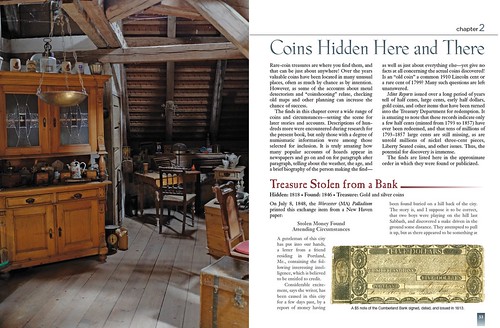
How do hoards come to be? This is a natural question, and one that has many answers. Some groups of coins were buried in yards or hidden in house partitions by wealthy people in an era when there were no banks or safe deposit boxes to offer secure storage. Many coins, including some fabulous cargoes of gold, went down with ships. Still others were concealed in cornerstones, secret compartments, or basement walls.
Uncle Sam also did his share of putting coins away. Bags of sparkling silver dollars were held in Mint and Treasury vaults for many years, only to come forth to delight a new generation of numismatists. Then there is the marvelous story of crates of pattern coins hidden in the Philadelphia Mint for many years, only to be revealed and to figure in an exchange of hitherto unknown $50 gold pieces in 1909.
Some hoards known today were concealed years ago to avoid capture by Indians, or by robbers, or by Yankee troops about to overrun a Louisiana plantation. Certain gold and silver coins found in the Midwest and West were taken in holdups or by some other illegal method and concealed in order to permit fast escape. The idea was that the site of the hidden loot would be visited later and under more leisurely circumstances, and the coins or paper money would be retrieved to be spent and enjoyed. Meanwhile, the crooks might have been killed by members of posses, or jailed by the local sheriff, or sidelined by some other end. After reading accounts of railroad robbers, ship pirates, bank holdups, and marauding soldiers, one can easily conclude that transporting or even owning a large holding of silver and gold coins in the 1700s and early 1800s was fraught with danger.
And reminiscent of the famous "Purloined Letter" story by Nathaniel Hawthorne, still other caches of coins and currency have been hidden in an obvious place—where else?—in a bank vault or in the Treasury Building in Washington.
As you read Lost and Found Coin Hoards and Treasures, many reasons why coins were concealed or lost will be revealed. Then again, in numerous instances no one will ever know who secreted these precious coins or why they did, as those involved died years or generations before their treasures were brought to light. For example, we do not know now, and may never know, who hid the thousands of large copper cents of the 1816 to 1820 years in the famous Randall Hoard (named after a later owner of the pieces).
Coins keep their secrets well; they tell no tales as to where they have been, what they have seen, and the roles they played.
To qualify for inclusion in my book, a hoard or find had to include American coins, paper money, or other numismatic items relating to the United States or its antecedent colonies. Such hoards were mostly found within the borders of our country, but some were not. (The SS Central America, the SS Republic, and the "Bank of France" treasures are but three examples of exceptions.)
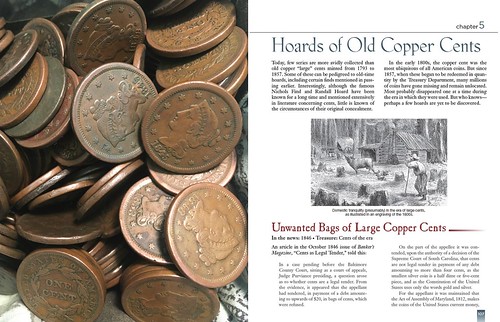
Hoards consisting entirely of foreign coins are not within the scope of his book, but much information on such finds can be found elsewhere.
No listing of hoards can ever be comprehensive, as there are countless thousands of instances in which members of the public have brought long-forgotten rolls, money purses, and other holdings to coin dealers or have otherwise disposed of finds without giving details to the press. Indeed, more than just a few treasure finders have found that publicizing their good luck was about the worst thing they could have done, as the news attracted many who sought to claim part of the coins as their own—based on former ownership of a property, a long-ago insurance settlement, or a modern desire to claim tax liability.
Case in point: while doing research for Lost and Found Coin Hoards and Treasures, I contacted several manufacturers and distributors of electronic treasure-detecting devices, and the typical reply to my inquiries was that "most of the people who find coins with our detectors keep the details secret."
And in other instances, misinformation has been given out to throw other treasure seekers off the track (e.g., in an 1850s newspaper account of early salvage attempts for the treasure of the SS Yankee Blade).
Adding even more intrigue are accounts of the "hoarders among us," detailing the activities of numismatists such as Virgil M. Brand, George W. Rice, John A. Beck, Colonel E.H.R. Green, and others who were collectors, but who enjoyed squirreling away quantities of favorite items. For example, Brand cornered six of the ten known 1884 silver trade dollars, and Colonel Green had each and every specimen of the five known 1913 Liberty Head nickels.
Finally, chapter 26—"Hoaxes, Fantasies, and Questioned Finds"—discusses holdings of coins and fantasy pieces that have been questioned and are believed to have been made later than the dates they bear or the eras from which they appear to be. Some such "hoards" are not hoards at all, but represent contrived stories: capers and taradiddles, many of which make fascinating reading today.
All in all, I hope that the accounts in Lost and Found Coin Hoards and Treasures will provide interesting reading, perhaps your own "treasure" of numismatic information and entertainment. Certainly, the book was a lot of fun to research and write.
Lost and Found Coin Hoards and Treasures, 2nd edition
By Q. David Bowers; forewords by Kenneth Bressett and Bob Evans
ISBN 0794846440
Hardcover, 8.5 x 11 inches
480 pages
Full color
Retail $39.95 U.S.
https://www.whitman.com/store/Inventory/Detail/Lost-and-Found-Coin-Hoards-and-Treasures-2nd-Edition+0794846440
To read the earlier E-Sylum article, see:
NEW BOOK: LOST AND FOUND COIN HOARDS, 2ND ED. (https://www.coinbooks.org/v22/esylum_v22n41a05.html)
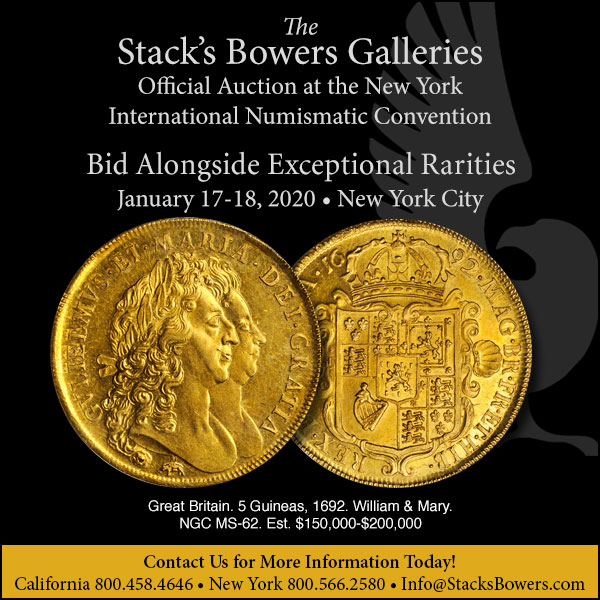
WHO DO YOU THANK IN A NUMISMATIC BOOK?
Over on Coin Update Dennis Tucker of Whitman Publishing published a thoughtful article on who authors should thank when writing a numismatic book. Here's an excerpt. I added the thank-you meme. -Editor
by Dennis Tucker
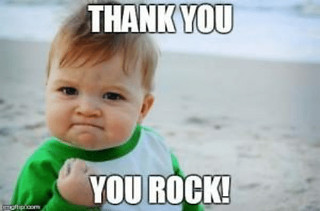 "It takes a village to raise a child," the old saying goes, and the same could be said about creating a good numismatic book. This brings to mind the most prolific
numismatic writer of all time, Q. David Bowers. One of Bowers's not-so-secret ingredients of success is an impressive network of helpful collaborators. His long career as an
author has benefited from other researchers sharing their findings and bouncing ideas around (of course, he always returns the favor). This flow of information is good for
everyone involved, not to mention the hobby community as a whole.
"It takes a village to raise a child," the old saying goes, and the same could be said about creating a good numismatic book. This brings to mind the most prolific
numismatic writer of all time, Q. David Bowers. One of Bowers's not-so-secret ingredients of success is an impressive network of helpful collaborators. His long career as an
author has benefited from other researchers sharing their findings and bouncing ideas around (of course, he always returns the favor). This flow of information is good for
everyone involved, not to mention the hobby community as a whole.
When you're writing a manuscript for a numismatic book, don't try to go it alone—look for opportunities to collaborate. And while you do, keep track of everyone who helps you along the way. You'll want to thank them in your book's credits and acknowledgments.
A credit is public indication of a source of information, ideas, or other content. (This can include scholarly footnotes/endnotes and citations; broad crediting for general inspiration, numerous acts of help, and the like; or credit for specific content.)
An acknowledgment is an expression of gratitude.
Here are a few types of people and organizations you should thank in your numismatic book. Compile a list or spreadsheet as you work. Creating a manuscript can take months or years, and it's easy to forget or lose track of contributors if you don't write them down.
Helpful research collaborators. Everyone who answers (or asks!) questions, follows up on leads, shares knowledge, or otherwise aids you in gathering and processing information.
Assisting organizations. Libraries, museums, archives, history centers, foundations, educational nonprofits, and similar sources. You can thank both the organization and any particularly helpful staff or officers. Often a communications department or copyright office will provide specific wording for certain kinds of credit (e.g., a museum might want you to list archive or collection numbers, donor names, or other source information).
Licensors and others who require credit. Unless your book's images come completely from your own photography and/or the public domain, you'll need to license or otherwise get permission for illustrations. Permission might be granted in exchange for credit in the book, or it might also require payment. Often it will require specific wording (e.g., "Image courtesy of the Town of Schroeppel Historical Society Museum") spelled out in a contract or permission letter. Keep especially careful track of such requirements as you go along.
Early readers and editors. Anyone who takes the time to read, critique, and offer feedback on drafts and revisions of your work is doing you a great service. Be sure to thank them publicly!
Personal inspirations. This can include a formal dedication to a loved one or a colleague or mentor, or broader acknowledgment of the help, sacrifices, or other inspiration provided by individuals or groups.
Door-openers. This might seem like a "kitchen sink" approach, but it's good form to thank those who don't necessarily roll up their sleeves and dig the trenches, but who put you in contact, grant permission or entry, smooth the way, grease the wheels, open doors, write letters of recommendation or reference, make introductions, and otherwise share their own connections and access, either personal or professional. It might be tempting to think, "Well, that person had to say ‘yes' to my request; it's their job"—but ask yourself, "Could they just as easily and defensibly have delayed or ignored me, or simply said ‘no'?" It doesn't cost you anything to acknowledge professional courtesies.
Excellent points! Thank you. See the complete article for a detailed case study from Dennis's book, American Gold and Silver: U.S. Mint Collector and Investor Coins and Medals, Bicentennial to Date. -Editor
To read the complete article, see:
Who do you thank in a numismatic book?
(http://news.coinupdate.com/who-do-you-thank-in-a-numismatic-book/)
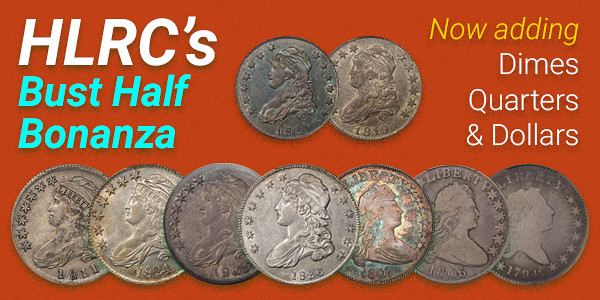
THE MINT MASTER ON NEWMAN PORTAL
The latest addition to the Newman Numismatic Portal is The Mint Master from the Utah Numismatic Society. Project Coordinator Len Augsburger provided the following report. -Editor
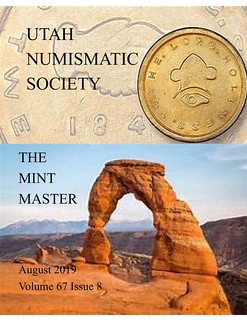 Recently added to the Newman Portal is The Mint Master, journal of the Utah Numismatic Society, for the years 2009-2019. State publications typically have a focus
on local numismatic emissions, and the Mint Master is no exception, with extensive coverage of 19th century Mormon issues as well as Utah obsolete currency. Local events,
not always covered by the national numismatic media, are also featured.
Recently added to the Newman Portal is The Mint Master, journal of the Utah Numismatic Society, for the years 2009-2019. State publications typically have a focus
on local numismatic emissions, and the Mint Master is no exception, with extensive coverage of 19th century Mormon issues as well as Utah obsolete currency. Local events,
not always covered by the national numismatic media, are also featured.
The November 2016 issue includes an article by Tom Davis covering the opening of a hundred-year old time capsule at the State Capitol Building. Newman Portal acknowledges editor Doug Nyholm, who is also a frequent Mint Master author, for his assistance with this title.
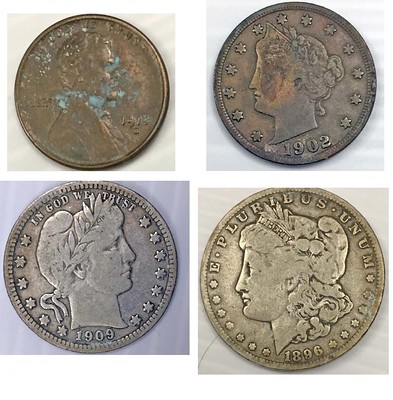
Image: Coins recovered in 2016 from Utah State Capitol Building time capsule, from the November 2016 Mint Master.
Link to The Mint Master on Newman Portal:
https://nnp.wustl.edu/library/publisherdetail/533919
VIDEO: VICTOR URBANO INTERVIEW
These are selections from the David Lisot Video Library that feature news and personalities from the world of coin collecting. David has been attending coin conventions since
1972 and began videotaping in 1985. The Newman Numismatic Portal now lists all David's videos on their website at:
https://nnp.wustl.edu/library/multimediadetail/522852
Here's an interview with Peruvian coin specialist Victor Urbano. -Editor
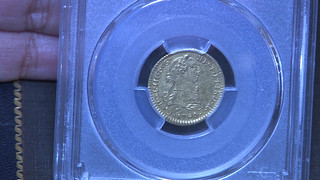 Victor Urbano, Peruvian Coin Specialist , David Lisot, Interviewer, CoinTelevision.com
Victor Urbano, Peruvian Coin Specialist , David Lisot, Interviewer, CoinTelevision.com
There was a collector who came to the convention who had an interest in coins of Peru and Latin America. He shared why his interest in coins and showed some "cool" items! For example: one Escudo gold 1780/79 overdate PCGS AU55, and 1832 Colombia ¼ Real Silver overdate NGC MS63.
This video is a highlight from:
US Mexican Numismatic Association Convention Highlights 2019
An excerpt of the video is available for viewing on the Coin Television YouTube Channel at:
https://youtu.be/Dr1MGpa1PoE

PERATROVICH DOLLAR RELEASE LOBBIED IN ALASKA
Dick Hanscom submitted this account of how the Fairbanks Coin Club proposed, and 4H students lobbied the Alaska State Legislature about the mintage and release of the Elizabeth Peratrovich Dollar coin. Thanks! Democracy in action. -Editor
The item on the U.S. Mint Forum prompted me to contact The E-Sylum with the following information.
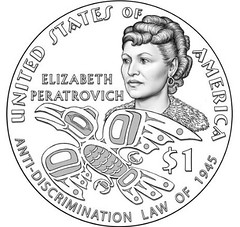 In January of this year, the Fairbanks Coin Club contacted the members of the Alaska State Legislature promoting the release of the then proposed Elizabeth Peratrovich
Dollar coin to circulation in Alaska. In the spring, local 4H leaders traveled to Juneau with a group of 4H'ers as part of the 4H Youth in Government program. They lobbied all
60 legislators for a resolution calling for the release of the Peratrovich Dollar to circulation in Alaska. They also met Paulette Mareno, Grand President of the Alaska Native
Sisterhood, who has been involved with the mint since the beginning of this project.
In January of this year, the Fairbanks Coin Club contacted the members of the Alaska State Legislature promoting the release of the then proposed Elizabeth Peratrovich
Dollar coin to circulation in Alaska. In the spring, local 4H leaders traveled to Juneau with a group of 4H'ers as part of the 4H Youth in Government program. They lobbied all
60 legislators for a resolution calling for the release of the Peratrovich Dollar to circulation in Alaska. They also met Paulette Mareno, Grand President of the Alaska Native
Sisterhood, who has been involved with the mint since the beginning of this project.
The results of the lobbying is HJR9, calling for the release of 5 million of the coins to be released to circulation in Alaska. The resolution can be viewed here:
http://www.akleg.gov/basis/Bill/Detail/31?Root=HJR9#tab1_4
You can watch the floor debate at:
https://www.360north.org/gavel/video/?clientID=2147483647&eventID=2019031256
Give it time to load. It will take a few seconds.
Testimony on HJR9 begins at about 23:00 minutes. The best part is at 42:30 minutes. Except for one long winded speech in opposition, the testimony is overwhelmingly positive.
With all the "odd" things the mint is currently doing, this gives me hope that this might just be possible. Since we don't get any of the "W" quarters in Alaska, this would be a great alternative.
Very cool. It's nice that the full video of the session is available. Open government at its best. Here's the key section of the bill. -Editor
"BE IT RESOLVED that the Alaska State Legislature requests that the United States Secretary of the Treasury, under the Native American $1 Coin Act, mint not less than 5,000,000 Elizabeth Peratrovich $1 coins to be issued at face value and delivered to the Seattle branch of the Federal Reserve Bank of San Francisco for distribution for deposit in banks throughout the State of Alaska; "
To read the earlier E-Sylum articles, see:
NATIVE AMERICAN COIN FIGURE PERATROVICH (https://www.coinbooks.org/v22/esylum_v22n42a16.html)
VIC MASON'S THOUGHTS ON U.S. MINT FORUM (https://www.coinbooks.org/v22/esylum_v22n45a14.html)

NOTES FROM E-SYLUM READERS: NOVEMBER 17, 2019
Obverse and Reverse in the EU, US and the World
Yossi Dotan writes:
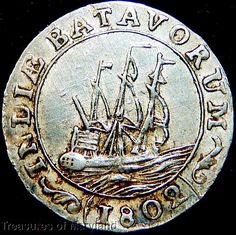 In my trilogy Watercraft on World Coins I applied the following rule: "The obverse is the side that depicts the image of the monarch, the coat-of-arms of the
republic or a similar symbol of sovereignty." The exception to this rule were the "ship coins" of the United States. As I wrote in the preamble of the United States
chapter, "In the United States, federal law defines which side of a coin is the obverse. The descriptions in this chapter follow the legislation. The obverse of regular
circulation coins is the side bearing the date. Commemorative coins sometimes bear the date on the reverse."
In my trilogy Watercraft on World Coins I applied the following rule: "The obverse is the side that depicts the image of the monarch, the coat-of-arms of the
republic or a similar symbol of sovereignty." The exception to this rule were the "ship coins" of the United States. As I wrote in the preamble of the United States
chapter, "In the United States, federal law defines which side of a coin is the obverse. The descriptions in this chapter follow the legislation. The obverse of regular
circulation coins is the side bearing the date. Commemorative coins sometimes bear the date on the reverse."
Euro coins have a common side and a national side. The national side indicates the issuing country. The common sides of the coins show images of the European Union or of Europe and symbolise the unity of the EU. The national side is considered the obverse.
Good choices. Thanks. As we've learned, it's quite hard to fashion a definition of obverse and reverse that accounts for the conflicting factors of legislation, die placement, and image or wording placement. -Editor
To read the earlier E-Sylum articles, see:
OBVERSE OR REVERSE? (https://www.coinbooks.org/v22/esylum_v22n44a08.html)
READER THOUGHTS ON OBVERSE AND REVERSE (https://www.coinbooks.org/v22/esylum_v22n45a10.html)
Translating to the Heavenly Realm?
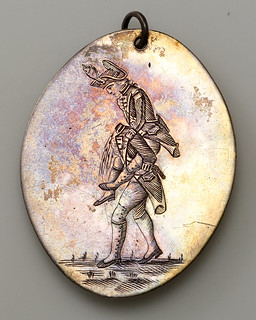
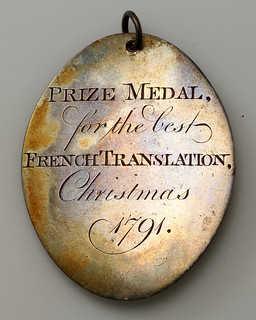
Bruce Bartelt writes:
On the headless soldier medal, might not the medal have the word "translate" being used in, or on a play on, its alternative definition of "to move from one place to another", or from the earthly to the heavenly realm?
Interesting interpretation. Anything is possible. We've had some great theories put forth. Perhaps future research will nail down a more definitive explanation. Great medal no matter what. Thanks. -Editor
To read the earlier E-Sylum articles, see:
HEADLESS SOLDIER MEDAL INFORMATION SOUGHT (https://www.coinbooks.org/v22/esylum_v22n43a14.html)
THOUGHTS ON THE HEADLESS SOLDIER MEDAL (https://www.coinbooks.org/v22/esylum_v22n44a09.html)
NOTES FROM E-SYLUM READERS: NOVEMBER 10, 2019 : Translating the Headless Soldier Medal
(https://www.coinbooks.org/v22/esylum_v22n45a12.html)
Ziploc® Bags for Safe Book Storage
Regarding safe, waterproof long-term storage for books, Scott Semans writes:
An eBay seller of a different product suggested Ziploc® bags. If I can find "freezer bag" quality in a large size, they might just do the trick.
Not a bad idea. Has anyone tried this? -Editor
To read the earlier E-Sylum article, see:
HOW TO STORE AND CARE FOR BOOKS SAFELY (https://www.coinbooks.org/v22/esylum_v22n45a26.html)
Bulk Coin Purchases
Earlier Jeffrey Zarit wrote that "In the 1950's Indian head cents were trading at 5 cents each by the hundred or thousand. Civil War tokens at 60 Cents each in groups of hundreds or thousands. Just unusual quantities of such items. I wonder, 60 years later, what happened to them." -Editor
J. Sheckherd writes:
I read Jeff's article with great interest, as I do remember that era clearly. I use to buy large lots of Indian head cent, civil war tokens and proof set to resell them, usually in smaller quantities. Unfortunately I thought erroneously that proof had a great future, since they were of the best quality you could expect and I kept them well beyond their peak. I also purchased a lot of Italian coins from Jeff to assemble a type set.
To read the earlier E-Sylum article, see:
NOTES FROM E-SYLUM READERS: NOVEMBER 3, 2019 : Thoughts on Numismatic Scrapbook
(https://www.coinbooks.org/v22/esylum_v22n44a10.html)
Spanish coins at Missouri History Museum
David Luftig passed along this photo of Spanish coins seen in an exhibit at Missouri History Museum is located in St. Louis. Thanks. -Editor

For more information on the Missouri History Museum, see:
https://mohistory.org/society
NumisTube
Kavan Ratnatunga writes:
NumisTube is a new YouTube channel specialized for numismatics with videos about coins, banknotes, orders, medals and related items. It's run by Russian Zlatko Viscevic (IBNS 10489-R) from Croatia.
To subscribe to NumisTube, see:
https://www.youtube.com/NumisTube
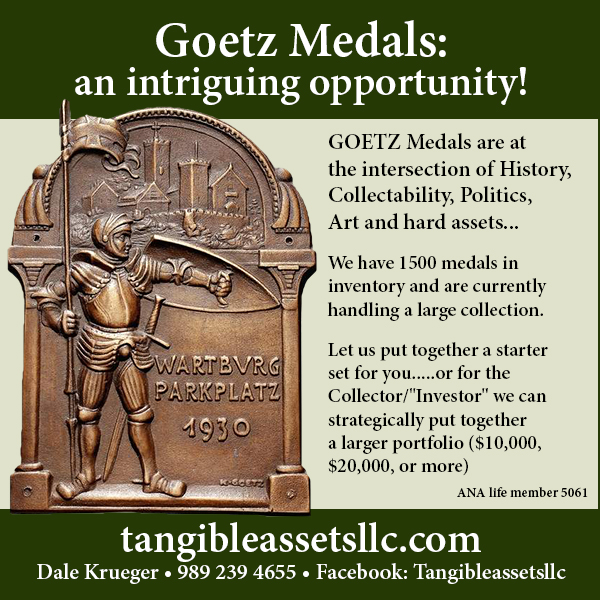
VOCABULARY TERMS: GOLDPLATE, GOLDPLATING, PART 2
This is the second part of an entry submitted by Dick Johnson from his Encyclopedia of Coin and Medal Terminology. Thanks. -Editor
Goldplate, Goldplating
How to tell goldplate from solid gold. Goldplate cannot be distinguished from solid gold by surface inspection. A test of nitric acid or touchstone will not differentiate the two. A tiny test cut is usually done on the edge of medals, searching for the color of gold or the base metal. This is not foolproof either as medal makers often choose a base metal of yellow brass or oroide because it will bleed yellow as does gold. (A nitric acid test at a test cut would reveal the base metal is not gold. See gold.)
The most obvious difference will be the object's weight. Solid gold will be heavier. Thus a specific gravity test will not only reveal the solid gold status (versus goldplate) but also will reveal the karat content (from 24 karat down to 9 karat; 8 karat and less is too similar to the specific gravity of other metals). Pure 24 karat and 22 karat is more than twice as heavy as most plated compositions. Such a nondestructive specific gravity test is obviously recommended over the destructive form of a test cut.
Marking goldplated objects. Goldplated objects are not required to be marked in any way unless the base metal is another precious metal. Solid gold objects are, of course, required to be marked with their true fineness in most industrial countries (since 1904 in England, 1906 in America). This is a current obligation reflecting the heritage of hallmarking in which all gold and silver objects were marked with symbols to identify the true nature and fineness of the metal. (The U.S. Mint does not honor this law, however, and their 20th century gold medals are unmarked.)
Now more progressive medal makers are revealing the nature of the base metal and better goldplated medals are edgelettered with the identity of the base metal and, often, the karat of the plated metal. This precludes the need of making a test cut, mentioned above, to see if an object is solid or plated. See edge lettering and numbering.
Reverse goldplating. Electrolysis can remove gold from a surface as well as add metal – in effect stripping off the gold from the surface of a goldplated item. By reversing the electric current the cathodic object becomes the anode and gives up the gold on its surface. The anode becomes the cathode and the gold collects on its surface. Previously depletion gilding obtained the same effect with firegilded objects. (Such objects need to be refinished quickly because this process creates an activated surface.)
Goldplated medals. The first goldplated medals were plated at silverware factories. Later (and particularly in 1890s) this was accomplished by jewelry manufacturers. Only in the 20th century were goldplated medals made by traditional medal makers; the wide popularity of "gold" award medals required medal manufacturers to provide goldplating as a necessary service to their clients.
Silver medals were goldplated to create vermeil (particularly after 1960 for the bullion medal demand). Bronze medals were goldplated and silverplated to create the gold-silver-bronze medal rank like those used for the Olympics.
Plating by national mints. Generally, goldplating is never done by a national mint. Coins intended for circulation, or medals intended for public sale, may be struck of a gold clad composition but never plated inside the mint. The U.S. Mint has never had the equipment nor the authority to electroplate a numismatic item of their manufacture. In certain instances these have been done outside the mint:
• A new design in 1883 of the U.S. five-cent piece (without the word cent) was goldplated outside the mint by unscrupulous persons whose intent was to passed them off as $5 gold pieces.
• Exposition officials of the Panama-Pacific Expo in 1915 wanted a goldplated version of their medal designed by John Flanagan and struck at the Philadelphia Mint. The goldplating was accomplished by Tiffany & Co in one of its jewelry plants.
• The issuance of a goldplated John Wayne Medal of 1979, was struck in bronze by the Philadelphia Mint, but was goldplated outside the mint by private companies.
Imitation gold. While goldplating is done to imitate solid gold (at a fraction of the cost), imitation goldplating can be accomplished with a gold tint lacquer (at even further savings in cost). References:
F1 {1876} Zowey.
F2 {1949} Blum and Hogaboom.
F3 {1954} Graham.
F4 {1963} Brenner.
F5 {1974} Lowenheim.
F6 {1975} Lins and Oddy.
F7 {1986} Rubenstein.
F8 {1987} Romankiew.
To read the earlier E-Sylum article, see:
VOCABULARY TERMS: GOLDPLATE, GOLDPLATING, PART 1 (https://www.coinbooks.org/v22/esylum_v22n45a17.html)
This is a very informative entry. I learned a lot, and expect many readers did as well. I was unaware of the process of reverse electroplating, for instance. -Editor
Looking for the meaning of a numismatic word, or the description of a term? Try the Newman Numismatic Portal's Numismatic Dictionary at: https://nnp.wustl.edu/library/dictionary
Or if you would like a printed copy of the complete Encyclopedia, it is available. There are 1,854 terms, on 678 pages, in The Encyclopedia of Coin and Medal Technology. Even running two a week would require more than 19 years to publish them all. If you would like an advance draft of this vital reference work it may be obtained from the author for your check of $50 sent postpaid. Dick Johnson, 139 Thompson Drive, Torrington, CT 06790.

JOHN C. LIGHTHOUSE (1844-1909)
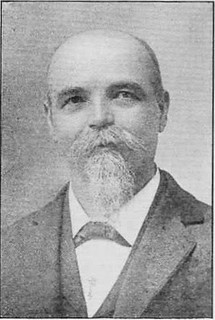 John C. Lighthouse (1844-1909), was born in March 1844, at Rochester, Monroe County, New York, son of German immigrants Johann Jakob Leuchtweiss (1813-1897), a nautical
engineer, and Anna Maria Liszt Lighthouse (1820-1891).
John C. Lighthouse (1844-1909), was born in March 1844, at Rochester, Monroe County, New York, son of German immigrants Johann Jakob Leuchtweiss (1813-1897), a nautical
engineer, and Anna Maria Liszt Lighthouse (1820-1891).
His family arrived in America in 1842 and sometime Anglicized the spelling to Lighthouse.
The 1850 U.S. Census places his birth in Germany in March 1844. However, in The Numismatist January (1905) : 28-29, he claims he was born in Rochester, New York. Charles Ricard, great-grandson of Lighthouse, settled the issue in his landmark and award winning article in January 1988, The Numismatist, pages 47-54.
He lived most of his life in Rochester, New York except for his long stays with his family in their residences out west in Washington and later on in California.
Lighthouse was an industrialist who began as a leather goods craftsman and rose to a national mail bag, and harness manufacturer. He began collecting in 1860 and his remaining collection including 660 proof coins was sold posthumously by J. C. Morgenthau at auction on February 18, 1936. His family and he were all abolitionists. He specialized in Roman and papal medals, but, especially in U. S. coins of all metals and denominations as well as paper money. Lighthouse had written : ' My United States series is as fine as I could obtain and approaches completeness in copper and silver and is quite good in gold; 1793 to 1857 good to uncirculated, and from 1858 in proof." He owned a specimen of the scarce Shultz & Co., San Francisco, 1851 $5 gold piece with the misspelling Schults & Co. He displayed the coin to George Bauer at his daughter's wedding on June 3, 1890. Only three were known to exist at the time. The other two were held by H. O. Granberg and Virgil M. Brand. His biography and photo first appeared in the January 1905 issue of The Numismatist. In August 1906, Thomas Elder complained against him in his own magazine remarking that he returned 44 lots of coins after winning them at auction. He says another dealer had a similar complaint and urged dealers not to sell to him at auction.
 In 1865, he opened a tanning factory making horse collars of straw and leather at 203-205 State Street, Rochester.
In 1865, he opened a tanning factory making horse collars of straw and leather at 203-205 State Street, Rochester.
In 1867, he married Margaret F. Lighthouse
From 1879 to 1885, Lighthouse was awarded the United States a U. S. patent and subsequently a contract to manufacture mail bags for the Post Office Department. That same year he purchased a 1794 silver dollar, an 1801/2 silver dollar, and a proof 1836 Gobrecht dollar, as well as an 1838 and 1839 silver dollars off Ed Cogan.
In 1880, he opened a large tannery in partnership with his brother in the firm J. C. Lighthouse and Brother. In 1883, he purchased a Stella proof set.
In 1885, like J. J. Mickley before him he was robbed of his coin collection valued at $60,000. Most of it was recovered from a married couple, the Gaffields. Among the loot was his three 1792 half dismes.
In 1887, while visiting out west with his family his factory burned down at an uninsured total loss of $135,000. He retired the rest of his life spending time with family, friends, traveling, and coin, fish, and game hunting.

In the April 1903 The Numismatist, page 122, Lighthouse is listed as a member who collects "all United States issues, foreign silver, ancient and modern." He was ANA member #479.
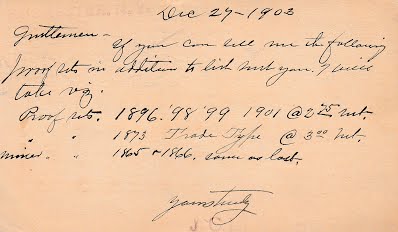
Lighthouse's correspondence with the Chapman Brothers, postmarked Rochester, December 27, 1903, soliciting proof sets needed. Recalling his statement cited earlier he boasted of his U. S. series in proof 1858 on we see where he was at this date. This remark was published by him in his brief biographical sketch in the January 1905, The Numismatist. "Gentlemen - If you can sell me the following proof sets in addition to the list sent you I will take seq. [the following] Proof sets . 1896. '98 '99 1901 @ 2.75 set; 1873 Trade Type @ $3 set' minor proof sets 1865 & 1866 same as last. Yours truly, J.C.H."
In October 1903, he visited his family in California remaining until Christmas but soon returned until May 1, 1904. In the January 1904 issue of The Numismatist on page 23 the announcement that "Mr. Lighthouse will pass the winter and spring in California where his address will be 2914 24th Street, San Francisco, California. This pattern remained for the following years 1905 to 1906.
In October 1904 Lighthouse joined the ANA Convention held on the St. Louis Fair Grounds and was active becoming elected to the board of trustees. He served on the board until 1907. He remained in Missouri hunting and fishing and afterwards to travel to New Orleans for the same during winter.
About this time Lighthouse held monthly coin chats at his home.
In 1905, he published the fact his coin collection weighed 400 pounds. George Bauer recalls he kept his gold coins individually wrapped in a nail keg.
Very fortunately, on April 16, 1906, two days before the devastating earthquake and fire he removed his entire holdings from the safe in the Safe Deposit Company vault at San Francisco to exhibit it for Farran Zerbe and fellow numismatists visiting at the Palace of Art bringing it home afterwards. Though he stored his coins at his house escaping the devastation downtown his home was badly shaken during the earthquake shattering the family china.
In 1908, Mrs. Lighthouse returned to Rochester, New York due to John's serious illness. She remained until after his demise settling the estate and its affairs.

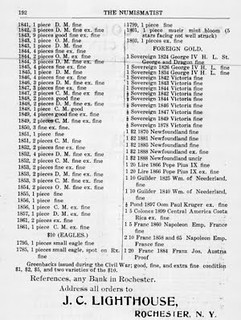
On June 30, 1908, Lighthouse sold 142 lots of his collection of coins at auction in The Numismatist pages 191-192.
On September 9, 1909, he died after a protracted illness at his home in Rochester. In his final moments he exclaimed he was surrounded in flames. Such a sad and poor ending to a story that should have ended bright!
To read the complete article, see:
LIGHTHOUSE, JOHN C.
(https://sites.google.com/a/numismaticmall.com/www/numismaticmall-com/lighthouse-john-c)
The entire inventory of the Lupia Numismatic Library is for sale. Individual items will be available before the remaining archives are broken up into parcels sold at philatelic auctions in the U. S. and Hong Kong. Check NumismaticMall.com frequently as dozens of new items with estimates will be posted daily until everything is sold.
All inquiries will be given prompt and courteous attention. Write to: john@numismaticmall.com .

HARVEY STACK'S NUMISMATIC FAMILY, PART 57
The latest article in Harvey Stack's blog series is about 1971 sales of U.S. pattern coins and Nate S. Shapiro Collection of ancient and world coinage. -Editor
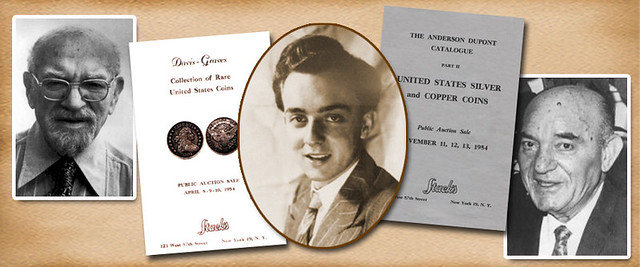
?In 1971, Stack's continued to offer specialized collections of United States coins, as well as world and Ancient coins. Most were smaller in scope but there were two major ones.
The first was held in conjunction with the annual American Numismatic Association Convention held in Washington, D.C. This Washington D.C. convention drew one of the largest crowds ever. Our 1971 ANA Sale featured a very comprehensive offering of nearly 2,600 lots and was appealing to all collectors, beginners or advanced specialists. Whether someone collected small cents or $50 gold pieces, in superb or average condition, there was something for everyone.
Among the more specialized collections was over 240 lots of United States pattern coins, from the cent through the double eagle, with an unusually large collection of small cent patterns. There was also a good selection of private and territorial gold, including rare $50 slugs. For the foreign coin collector we had a superb group of world crowns, with a specialized offering of English crowns, and Russian gold, silver and platinum pieces. It was indeed a wonderful offering!
In fall 1971 we offered 1,269 lots of the collection initially formed by John Quincy Adams, who during his travels as Ambassador, mostly to Europe, gathered a splendid collection of world coins that circulated during his time abroad. The collection was eventually given to the Massachusetts Historical Society. In 1971 these coins were sold to help preserve the famous Adams Papers as well as further the ongoing mission of the Society. The proceeds were also used for new showcases and the establishment of larger display areas, along with enlarging the library to store more manuscripts and books.
In the later part of 1971 we were asked to auction the famous Nate S. Shapiro Collection which included coins from the ancient world through to modern coins of Europe and the other continents, together with a great selection of paper currency. Nate, a native of Detroit, Michigan, built his collection with the goal of showing it to school children as well as fellow collectors to advance the education of the observers. It was a perfect collection on which to build a lecture series about numismatics and monetary history. He donated his collection to the Detroit Museum. As they did not have room to show it in its entirety, the museum selected coins of historical and monetary importance and built a display about it. The money from the sale of the other pieces was used to provide a curator and lectures about numismatics.
As you can see, museums do not always have room to display all that is given to them, nor do they always have funds to provide for a curator and programs. So in order to serve visitors and students, museums decide which items will tell the story they wish to tell. Then the duplicates or items that do not relate to the main message can be sold to support the mission of the institution.
Over the years, Stack's has had the privilege of assisting many institutions to maximize their resources to provide the best educational outcomes. In my next parts I will cover 1972 through 1973, when many changes and events occurred.
To read the complete article, see:
Harvey Stack Remembers: Growing Up in a Numismatic Family, Part 57
(https://www.stacksbowers.com/News/Pages/Blogs.aspx?ArticleID=Harvey-Remembers-Part57)
To read the earlier E-Sylum article, see:
HARVEY STACK'S NUMISMATIC FAMILY, PART 56 (https://www.coinbooks.org/v22/esylum_v22n44a14.html)
2019 SALTUS AWARD TO MASHIKO
Mashiko has received the 2019 J. Sanford Saltus Award for Excellence in Medallic Art. -Editor
The American Numismatic Society Presents its 2019 J. Sanford Saltus Award for Excellence in Medallic Art to Mashiko Nakashima
 The American Numismatic Society is pleased to announce that Mashiko Nakashima is the recipient of the Society's prestigious 2019 J. Sanford Saltus Award for Signal
Achievement in the Art of the Medal.
The American Numismatic Society is pleased to announce that Mashiko Nakashima is the recipient of the Society's prestigious 2019 J. Sanford Saltus Award for Signal
Achievement in the Art of the Medal.
Mashiko grew up in her father's home city of Kyoto, Japan. In 1962 she moved to the United States, and in 1964 to New York City. There, in 1993, she founded Medialia … Rack and Hamper Gallery, a showplace for contemporary medallic art. Seven years later she founded New Approach, Inc., a nonprofit organization that promotes emerging artists and curators and serves as a contemporary medallic-art research center.
As a prolific sculptor and medallic artist, Ms. Nakashima has received numerous awards, including the American Numismatic Association's Excellence in Medallic Sculpture Award and the Grand Prix at the XXXV Fédération Internationale de la Médaille d'Art (FIDEM) Congress. Her stone sculptures, medallic art, silkscreen prints, and drawn illustrations are in numerous public collections around the world, including the Cincinnati Art Museum, the National Museum of Taiwan, Kyoto City Hall, the Queens Museum (New York), the American Numismatic Society, the American Numismatic Association, and the British Museum. Her many commissions, from organizations such as the British Art Medal Society and the New York Numismatic Club, include one for a memorial granite headstone for the feminist activist and author Betty Friedan. She has also been invited to submit designs to the U.S. Mint.
In addition to her extensive creative endeavors, she has also been a tireless teacher of her craft, offering courses in medallic and stone sculpture at The University of the Arts, Philadelphia, for two decades (1993 – 2013). Since 2001 she has also conducted private book-art, medal and urushi workshops.
"Mashiko is unquestionably deserving of the Award," noted Saltus Committee Chairman Donald Scarinci, "not only for her wonderfully creative medallic art, but for all that she has done to teach and promote the medal as well. We are especially pleased to present the Award to her this year, the centennial year of the Award."
The ceremony will take place at the ANS headquarters in New York City on Thursday, December 12, 2019, at 6 P.M. The Saltus Medal will be presented to Ms. Nakashima by ANS Executive Director Dr. Gilles Bransbourg.
The award was created with a grant to the American Numismatic Society by J. Sanford Saltus in 1913 to recognize and encourage excellence in the art of the medal. The first Saltus Award was presented in 1919; the silver award medal was designed by the prominent German-born numismatic and architectural sculptor Adolph Alexander Weinman.
Mashiko Nakashima joins the ranks of other significant artists who have been awarded the medal including, among dozens of others, James Earl Frazer (1919), Victor D. Brenner (1922), Paul Manship (1925), Lee Lawrie (1937), Donald DeLue (1967), Kauko Räsänen (1986), Gustaaf Hellegers (2001), and João Duarte (2011), and Bogomil Nikolov (2017).
To read the complete article, see:
2019 Saltus Award to Mashiko (http://numismatics.org/2019-saltus/)
Congratulations! I had the opportunity to meet Mashiko and visit her gallery in April 2019, and documented the encounter in my Numismatic Diary -Editor

Mashiko with Wayne Homren at Medialia Gallery
To read the earlier E-Sylum article, see:
(https://www.coinbooks.org/v22/esylum_v22n16a25.html)
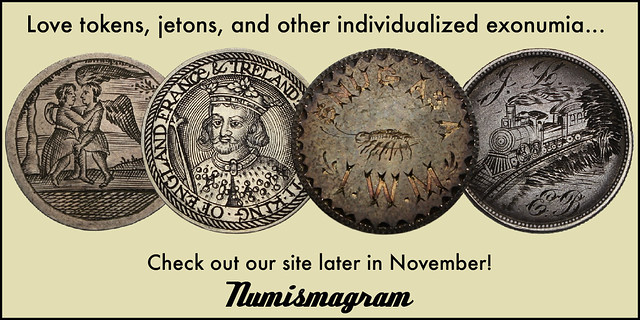
EXHIBIT: NOTGELD AT THE BRITISH MUSEUM
Here's an excerpt of a review of the current exhibit of German notgeld at the British Museum. Found via the November 5, 2019 (Volume V, Number 20) issue of News & Notes from the Society of Paper Money Collectors. -Editor
In the British Museum at the moment is an exhibition about a period of German history that's both well known, and hardly known at all – the hyperinflation of the world war periods.
While many of us who paid attention at school will remember images of people carrying huge piles of cash to buy food, but what's not taught is what those bank notes looked like – and it's not what you expect.
As the central bank couldn't supply the metal for coins, it eventually lost control over currency and local banks and even independent institutions started issuing their own paper currency – the Notgeld (necessity money) and with no central control, the design of the bank notes exploded with creativity.
This Notgeld's text and image tells the local story of a "farting coppersmith", which was a famous story at the time.
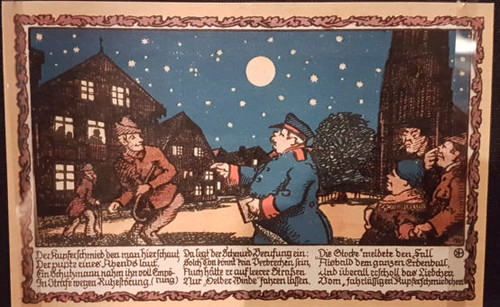
In Notgeld world, money would be funny.
And that's really what the exhibition is about – the many different designs for the money, and how they often poked fun at local customs, or held hidden criticisms of the government.
This seemingly ordinary note has been very subtly edited so that some of the text in the circles instead of saying "Niederlahnstein 1917" carried a message criticizing food shortages. The maker was arrested when the alteration was noticed.
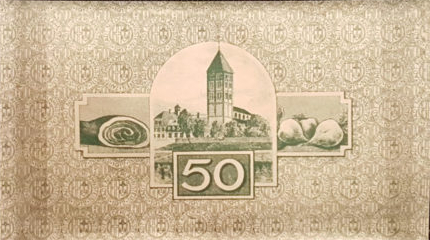
To read the complete article, see:
Exhibition Review: Notgeld and the farting coppersmith
(https://www.ianvisits.co.uk/blog/2019/11/05/exhibition-review-notgeld-and-the-farting-coppersmith/)
Here's the official exhibit description from the British Museum web site. -Editor

Notgeld with value of 25 pfennig, issued in Brocken, Germany, 1922.
Notgeld, or ‘emergency money', from the early Weimar Republic, is a powerful illustration of the turbulent years during and after the First World War in Germany.
This exhibition reveals how this temporary currency responded to a national crisis with distinctive designs commenting on German society and politics. These range from the Turnip Notgeld lamenting the disastrous food shortage of 1917, to richly illustrated designs featuring regional landmarks and folk narratives, intended to buoy a population hungry for reassurance.
In its short lifespan, Notgeld's purpose and design changed dramatically. It was introduced as a substitute currency during a coin shortage in First World War, with patriotic and sometimes subversive messages. Popular with German people, it became highly collectible and then, during the hyperinflation of 1923, regained its role as an alternative currency. In the chaotic early years of the Weimar Republic (1919–1933), designs often depicted idealised views of German history and culture as well as exciting travel advertisements, appealing to a people longing to shake off the bitter war years.
Intrinsically bound to German identity and the upheaval that followed the First World War, Notgeld is a fascinating microcosm of public feeling in post-war Germany.
For more information, see:
Currency in crisis German emergency money 1914-192
(https://www.britishmuseum.org/whats_on/exhibitions/currency_in_crisis.aspx)

A THEFT AT THE ROYAL COIN CABINET
Last week we reported on two high-profile coin burglaries. Coin thieves were harshly dealt with in 1700s Germany, as shown by a Bookophile blog article published this week.
Bookophile is a project of the Zurich MoneyMuseum in cooperation with CoinsWeekly, featuring information on the history of and the market in books printed mainly between 1500 and 1800. The stories are a great source for the history of ideas, mind and everyday life in that period.
Here's an excerpt from the article by CoinsWeekly editor Ursula Kampmann. -Editor
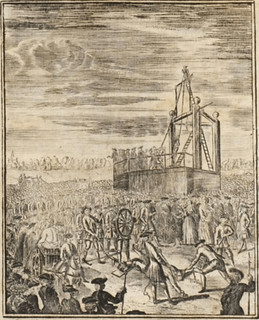 The theft would have gone unnoticed if the court locksmith would not have tried to sell one of the gold coins to a gold smith. The smith was surprised to see the rare
piece. He contacted La Croze and the latter made sure that Stieff was arrested immediately. As it was common back then, the suspect was tortured so that he would confess the
crime. However, Stieff continued to maintain that he found the coin.
The theft would have gone unnoticed if the court locksmith would not have tried to sell one of the gold coins to a gold smith. The smith was surprised to see the rare
piece. He contacted La Croze and the latter made sure that Stieff was arrested immediately. As it was common back then, the suspect was tortured so that he would confess the
crime. However, Stieff continued to maintain that he found the coin.
At this point, his accomplice lost his cool. He claimed in writing that there had been a robbery at the royal coin cabinet. Stieff only picked up one of the coins that had been dropped by the robbers. This seemed strange to the authorities. Runck was arrested and he confessed the crime while being tortured.
The Punishment
The entire population of Berlin was watching when the punishment of the thieves took place. Let us quote from the Chronicles of Berlin, Potsdam and Charlottenburg published
in 1843: "Both were sentenced to be pinched with burning irons at all crossroads on the way to the place of execution, and then to be broken on the wheel alive. The execution …
took place on 8 June 1718. The castellan, who had been the actual instigator of the crime, was carted through the town on a tumbrel and pinched with burning irons while the
locksmith went on foot in front of the vehicle. The delinquents' wives followed the cart and had to witness the execution of their husbands. First, the locksmith was punished in
the way his sentence demanded it, then, the same happened to the castellan; subsequently, both women were beaten up with a rod and sent to the prison in Spandau whereas the
children were taken to the orphanage and only 3,000 talers of the considerable fortune of both men was deposited for their maintenance."
Be sure to read the complete article and learn why the spectators at the time thought the harsh punishment to be fair and just.
Bookophile is published online every two weeks on Wednesday. To subscribe to the English version, see:
https://bookophile.com/newsletter/?lang=en . -Editor
To read the complete article, see:
Crime and Punishment (https://bookophile.com/crime-and-punishment/?lang=en)
To read the earlier E-Sylum article, see:
NUMISMATIC BURGLARIES: BRESSETT, TOULEMONDE (https://www.coinbooks.org/v22/esylum_v22n45a09.html)
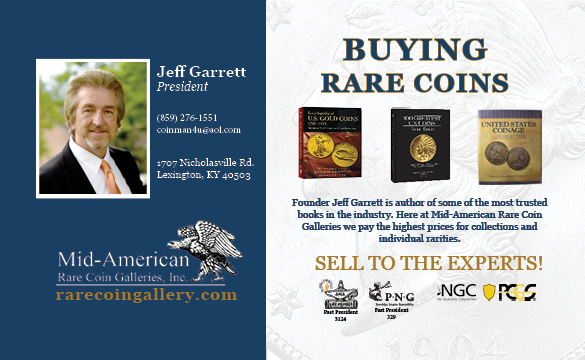
NUMISMATIC AUCTIONS LLC SALE 64 SELECTIONS
Here's a selection of lots that caught my eye in the upcoming November 21, 2019 sale from Numismatic Auctions LLC. -Editor
Lot 79: 1881 Shield Nickel

Nickels 1881. Key date. PCGS doily holder CAC green tag PR64 with original sky blue toning and watery mirrors. Cool coin in an elusive slab, worth a premium bid
Beautiful coin. -Editor
Lot 253: 1871 Nickel Pattern Judd-1054
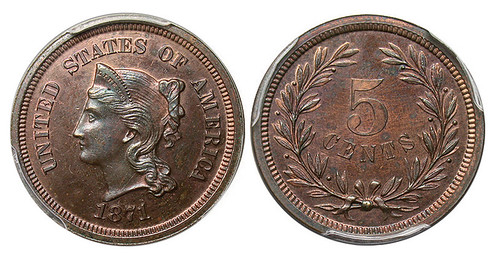
Copper 5 Cents Pattern, 1871. Judd-1054. PCGS Shield PR63RB with desirable color and a very unique design – seldom obtainable.
I've always loved pattern coins, particularly the five cent ones. I remember being captivated as a young collector by the photos in a COINage magazine article. -Editor
Lot 282: Henry Cook Storecards and Priced Catalogs
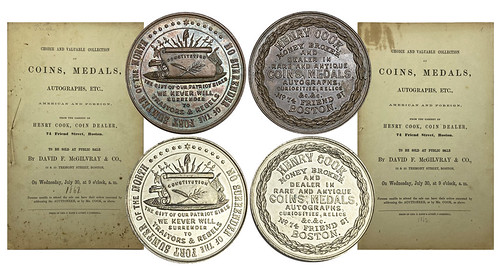
Very Rare Original Boston, Massachusetts Henry Cook - Money Broker & Numismatic, Antiquity and Curio Dealer Medals and Catalog Pair. Features AE & WM examples of variant MA115Aa1a/e, R8 depicting the Constitution, cannon, flag, weapons and accoutrements, beautiful iridescent brown and P/L Unc along with a wonderful original pair of identical Auction Catalogs offering Coins, Medals & Autographs from the cabinet of Henry Cook, dated July 30, 1862. The booklets each with handwritten notes of prices realized – one in ink, the second in pencil. The 662 lot catalogs detail a fabulous listing of English, Colonial and U.S. Coins, early Medals, Cents, Half Cents, Patterns, Ancients, World Coins and much more, catalogs VF with slight foxing and natural paper age, otherwise nice. A spectacular find and a terrific opportunity for the Boston area numismatist! 4 items in all. ($750-1000)
Great tokens from a famous old-time dealer, with something for bibliophiles as well. -Editor
Lot 391: Canadian Five Cent Coin Set
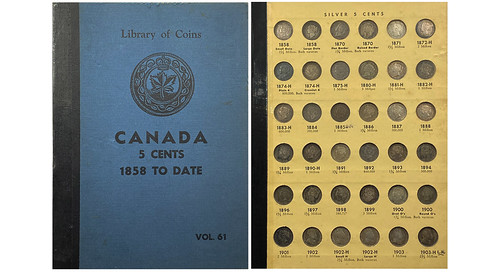
Noteworthy Vintage Collector Assembled Five Cents Silver & Nickel Set in Original Library of Coins Album. Features Five Cents Silver, 1858 to 1920, complete by date, mint and major varieties along with a similarly complete set of Nickel Coinage from 1922 to 1975. All hand-selected and meticulously built over a number of years. Good to BU with many better grades throughout and originality being a huge plus. Rather than break up this collection, we offer it instead intact to you. The consignor notes a very strong Charlton catalog value into the high four figures for the grades present. Close inspection is strongly recommended, nice collector examples abound and are minus the typical cleanings and damage that plague this series. 55 Silver + 60 Nickel coins in the original album.
A classic collection, assembled the old-fashioned way. -Editor
Lot 463: Philip II Gold Stater
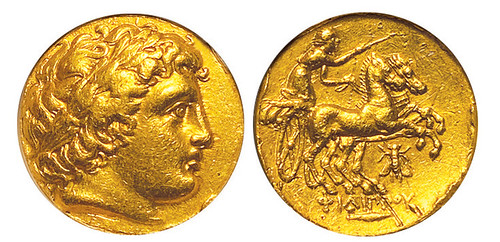
The Macedonian Kingdom. Philip II, 359-336 BC. AV Stater. Pella Mint. Laureate head of Apollo r.; Rx: Galloping biga r. ANACS EF45,
Impressive design. -Editor
Lot 479: Alexander the Great Tetradrachm
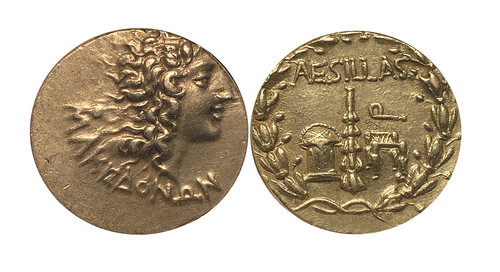
Thessalonika in Macedonia – Aesillas as Quaestor, 90-75 BC. AR Tetradrachm. Alexander the Great, wearing horn of ammon; Rx: AESILLAS Q, club, money chest and Quaestor's chair all within laurel wreath. ANAC
I guess it was the flowing hair locks that caught my eye on this one. -Editor
Lot 553: Fish Money
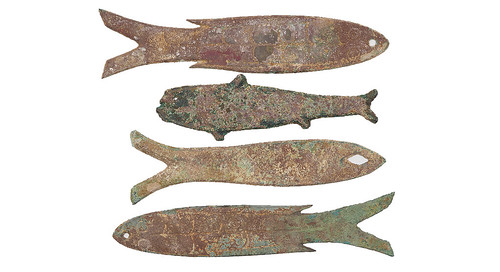
Ancient Bronze Fish Money Western Zhou Dynasty, 1100-771 BC Rare Fish Money Quartet, ND(c.1046-771 BC) 98mm to 127mm long, 19.6g to 28.1g each. Avg pleasing VF, one VG-Fine with simple silhouette style designs including fins and an integral piercing at the eye as made for suspension. All with attractive, smooth Salmon to Sea Green colored patina. 4 pcs. ($200-300)
For the collector of odd & curious. Or odd & curious collectors. But seriously, folks, these are great numismatic items. -Editor
Lot 606: Round Hole Cash Coin

Round Hole Cash Coin Pair, ND. Two 35mm examples, 7.6g and 7.5g respectively. Feature similar designs to prior lot yet one on rt the other on the left side. Avg Fine with brown to dark brown patina, one with natural flan clip. 2 coins. ($300-400)
Chinese cash coins have square holes don't they? Well, not all of them. The sale includes several rare round-hole cash pieces. -Editor
Lot 611: Early Silver Sycee Ingot
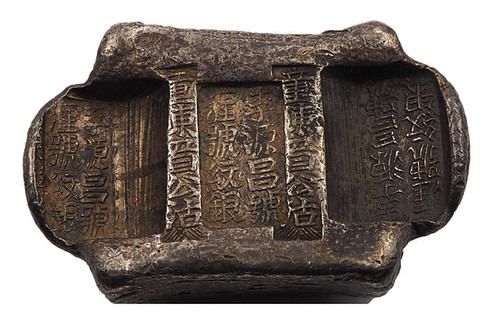
Yunnan Sanchuo Jieding. Provincial Three Stamp Remittance Ingot. Silver 5 Tael Bank Ing
Interesting an popular. But let's see 'em slab that! -Editor
Lot 852: 1780 Maundy Set

1780. KM-MDS57. Handsome original gold, blue and violet pewter toned AU-Unc to Unc. 4 coins. ($200-250)
The sale as a very long run of these great, inexpensive sets. -Editor
Lot 1164: Costa Rica Specimen 100 Colones Banknote
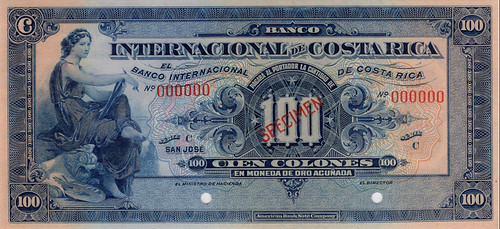
Costa Rica Specimen 100 Colones, ND(c.1919-1932). P-178s. Desirable Unc with nice color and paper quality. ($250-300)
Attractive note - lots of great banknotes in this sale. -Editor
To read the earlier E-Sylum article, see:
NUMISMATIC AUCTIONS LLC SALE 64 (https://www.coinbooks.org/v22/esylum_v22n45a20.html)
THE BOOK BAZARRE
ARCHIVES INTERNATIONAL SALE 56 SELECTIONS
Here's a selection of lots that caught my eye in the Archives International Sale 56, closing November 21, 2019. -Editor
Lot 9: Australia 1949 £1 Pound Banknote
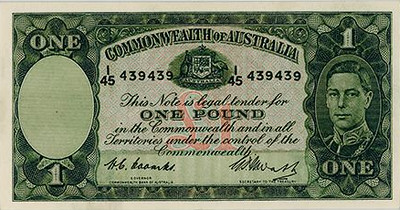
Australia. £1 Pound, ND (1949), P-26c, R31, Issued banknote, King George VI at right, S/N I/45 439439. PMG graded Extremely Fine 40 (Cert # 8060193-007).
To read the complete lot description, see:
Commonwealth of Australia. ND (1949). Issued Banknote.
(https://auction.archivesinternational.com/Commonwealth-of-Australia-ND-1949-Issued-Banknote_i34766158)
Lot 26: Bolivia 1973 Cobija Proof Banknote
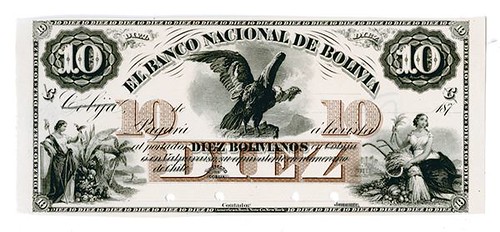
Cobija, Bolivia. 20 Bolivianos, P-S187p, Proof printed on india paper that is unmounted, Black on tan underprint, 4 small POC's in signature blocks, Potosi city scene in middle over title, Sucre at lower left, seated allegorical woman with globe on lower right, the note has 4 large to ample margins. The note would of graded Choice to Gem Uncirculated but there is a very light horizontal fold about 1/2 inch from the top margin. The note was evidently used in the design-production department. There are numerous text areas crossed out with pencil that refer to Cobija as well as the text below the denomination that the city is above. Cobija (previously known as Puerto La Mar) was the first significant Pacific Ocean port of independent Bolivia. It was lost to Chile in 1884. At the end of the War of the Pacific in 1884, the city and the entire coastal province of Bolivia was annexed by Chile. ABNC. Rare if not unique archival production department proof.
Very interesting proof note. -Editor
To read the complete lot description, see:
Banco Nacional De Bolivia, 187x (1873)
"Cobija" Proof Banknote Used as a Model.
(https://auction.archivesinternational.com/Banco-Nacional-De-Bolivia-187x-1873-Cobija-Proof-Banknote-Used-as-a-Model_i34766175)
Lot 137: Szechuen Province, 1921 Chungking Banknote
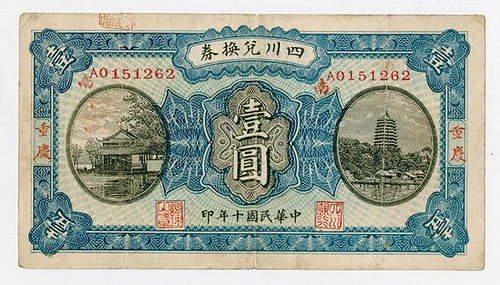
Chungking, China. $1, P-S2827a, S/M#S104.5-11a, Black on blue border, VF to VF+, Scarce note that has only shown up at auction 3 times since 2006.
Nice note - it could be the color that drew me in - I like blue! -Editor
To read the complete lot description, see:
Szechuen Province, 1921 "Chungking" Issue Banknote.
(https://auction.archivesinternational.com/Szechuen-Province-1921-Chungking-Issue-Banknote_i34766286)
Lot 232: East African Currency Board, 1933 Banknote
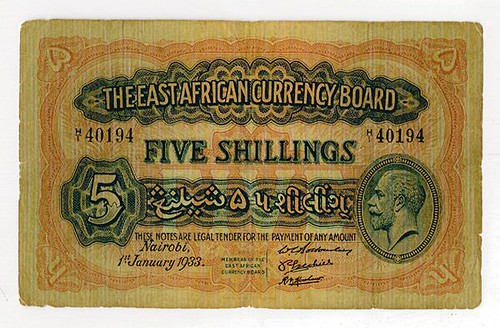
Nairobi, East Africa, 5 Shillings, P-20, issued banknote, blue-black on orange and light yellow underprint, King George V at lower right, back orange with lion in middle, S/N 40194, Fine to Fine+, Attractive note. TDLR.
To read the complete lot description, see:
East African Currency Board, 1933 Nairobi Issue Banknote.
(https://auction.archivesinternational.com/East-African-Currency-Board-1933-Nairobi-Issue-Banknote_i34766381)
Lot 332: Malaya 1942 $100 Banknote
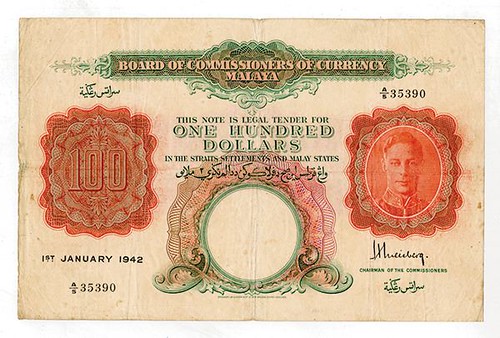
Malaya. $100, P-15, Issued banknote, red and green, King George VI at right, back red, S/N A/5 35390, Choice Fine to VF with one small pin hole in center, sharp corners, bright colors and intact edges with no faults or small tears, Attractive large format note that is sure to attract attention. BWC.
To read the complete lot description, see:
Board of Commissioners of Currency Malaya,
1942 $100 P-15 Issue Banknote. (https://auction.archivesinternational.com/Board-of-Commissioners-of-Currency-Malaya-1942-100-P-15-Issue-Banknote_i34766481)
Lot 868: St. Louis, MO 1907 Panic Scrip
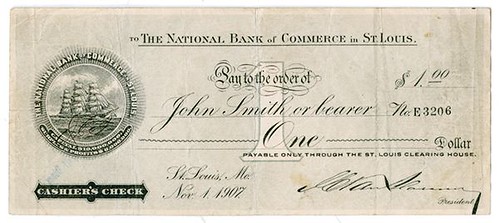
St. Louis, Missouri, November 1st, 1907. $1 Issued and uncancelled scrip note. Black on light gray paper, ornate design with Bank arms at left, blank back, VF condition. S/N E3206, Rare 1907 Scrip note, No printer listed, First time seen by cataloger.
The 1907 panic scrip is an overlooked series and many of the notes are quite rare. I collected the Pittsburgh 1907 notes for many years. -Editor
To read the complete lot description, see:
National Bank of Commerce in St. Louis, 1907
Depression or Panic Currency. (https://auction.archivesinternational.com/National-Bank-of-Commerce-in-St-Louis-1907-Depression-or-Panic-Currency_i34767017)
Lot 999: Tom's River, NJ. 1862 Obsolete Scrip Note
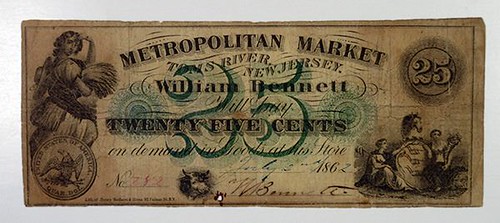
Toms River, NJ. July 2, 1862, 25 cts, Wait 2260, Black on green underprint, R-7. Metropolitan Market issued scrip during the Civil War to alleviate the coin shortage caused by hoarding. Choice VG to Fine, Rare note, no examples have appeared at auction.
I collected Civil War scrip for many years. It's a fascinating and never-ending series. Great note. -Editor
To read the complete lot description, see:
Tom's River, NJ. Metropolitan
Market-William Bennett. 1862 Obsolete Scrip Note.
(https://auction.archivesinternational.com/Tom-s-River-NJ-Metropolitan-Market-William-Bennett-1862-Obsolete-Scrip-Note_i34767148)
To read the earlier E-Sylum article, see:
ARCHIVES INTERNATIONAL SALE 56 ANNOUNCED (https://www.coinbooks.org/v22/esylum_v22n44a21.html)
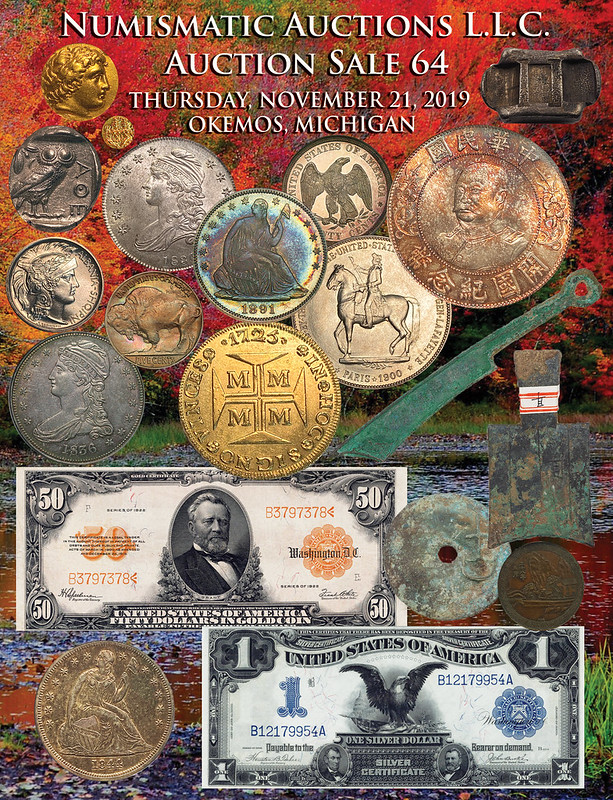
WAYNE'S NUMISMATIC DIARY: NOVEMBER 17, 2019
About 1pm Friday November 15, 2019 I arrived at the Whitman Baltimore Coin Expo. The first numismatic personality I spotted in the lobby was Victor England of Classical Numismatic Group. I soon ran into locals Ken Fritsch and Drage Vukcevich from my coin club, and we chatted for a bit. Both had been there all day and were leaving as I was just walking into the lobby.
I headed back to the last aisle, planning to do a complete circuit. Along the way I encountered Garrett Ziss, who told me about a U.S. large cent he was contemplating purchasing. The rest of my afternoon was a blur, stopping at tables and bumping into friends old and new along the way.
David Lange
My first stop was at the NGC booth where I spoke with Dave Lange, a regular E-Sylum contributor. He was looking happy and healthy after a recent health issue, and it was
great to see him.
American Numismatic Society
At the ANS table I waved hello to Mary Lannin and met Jesse Kraft, the new Assistant Curator of the Coins and Currency of the Americas. A former student at the Eric P. Newman
Graduate Summer Seminar in Numismatics, Dr. Kraft's research specialties include the circulation of foreign coins in the U.S. thru 1857, and the transition from the large to
small U.S. cent. His thesis and dissertation papers are not yet available on the ANS or Newman Portal sites, but I'll look forward to reading them once they are. I wish
I'd had more time to chat - those are subjects I've always been curious about - my own specialty is the period that followed, the Civil War era.
I also greeted and congratulated Dr. Gilles Bransbourg, the new ANS Executive Director. I don't get to New York very often, but I'm already looking forward to my next visit.
Jessie Zhang
Next to the ANS table was Jessie Zhang, whom I'd met at the ANA National Money Show in Pittsburgh earlier this year. We talked for a bit and I invited her to send along
interesting new items from her stock for our readers to learn about.
Xander Leijen
At the table of Schulman b.v. from Amsterdam I met Xander Leijen and owner Eduard Absil. Both are new E-Sylum readers. Xander and I spoke about E-Sylum and
numismatic digitization on the Newman Numismatic Portal.
Shanna Schmidt
I found American Numismatic Association Board Member and E-Sylum supporter Shanna Schmidt and her Mom Ellen manning Shanna's table. Known for her expertise in ancient
coins, Shanna also deals in interesting world coins. I snapped a couple photos before my phone's charge ran out.
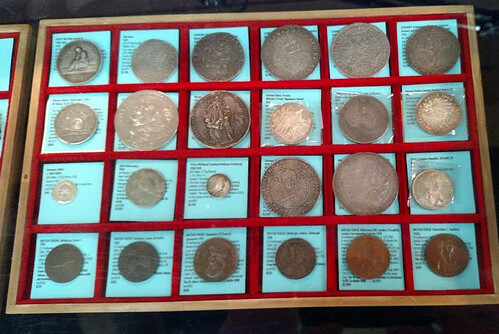
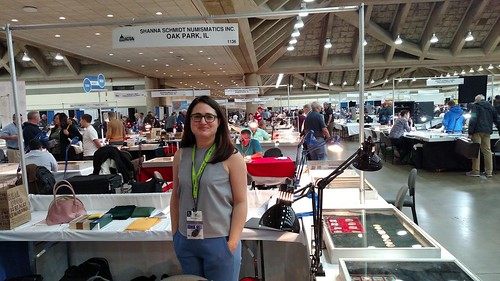
Charles Davis
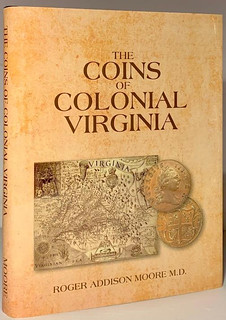 Over at numismatic literature dealer Charlie Davis' table I met up with Len Augsburger. We made plans for dinner where we could discuss our work with the Newman
Numismatic Portal.
Over at numismatic literature dealer Charlie Davis' table I met up with Len Augsburger. We made plans for dinner where we could discuss our work with the Newman
Numismatic Portal.
While at the table a man came by and left three coin scales for Charlie to sell for him. Len and I talked about Eric Newman's 1999 book on coin scales authored with George Mallis. Kolbe & Fanning may still have copies in stock - some remainders were discovered in Newman's estate.
We also discussed the International Society of Antique Scale Collectors (ISASC), which is planning to host back issues of their journal on the Newman Portal.
Before leaving Charlie's table I picked up a copy of Roger Moore's new book on the coins of colonial Virginia.
Jimmy Hayes
I walked Len over to the table of the Liberty Seated Collectors Club (LSCC). There we ran into former Congressman Jimmy Hayes, now the Executive Director of the Industry Council
for Tangible Assets (ICTA).
He told us a great story. His father was well known and connected in their community and one day the manager of a small town bank in Louisiana contacted him about some old coins they'd found while cleaning their vault. He connected him with Jimmy. It turned out to be an original untouched mint bag of 1907-O Half Dollars. He bought the whole thing. Like bags of silver dollars, many had some bag marks but many others were nearly pristine uncs. Here's a generic image from NGC Coin Explorer.

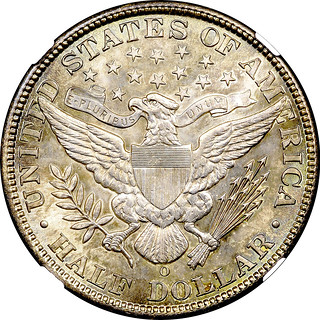
https://www.ngccoin.com/coin-explorer/barber-half-dollars-pscid-41/1907-o-50c-ms-coinid-16510
Bob Schwartz
At the table of Archives International I met up with longtime E-Sylum supporter Bob Schwartz and his wife. He'd printed a small number of hardcopy catalogs of his
current sale. He stopped printing and mailing them to most of his bidders some time ago.
However, his virtual online catalog and the printed version now include images of nearly every lot in the sale, a big change from the days when only selected lots got pictured due to space and expense constraints. This makes it ideal for browsing.
I mentioned that since Stacks Bowers often send me hardcopies, that makes it easier to browse the sale looking for items to highlight in a "Selections From..." article. It's just harder to click thru a long sale online than to just flip the pages of a physical book.
So I gave him a web site feature suggestion. It's something I don't think I've seen many sites implement, but what I think would be really useful is a scrolling page featuring ONLY images of the lots in the sale. It would make it MUCH easier and faster to browse the sale online. People are visual thinkers. We can flip through images very quickly and immediately zero in on something that stands out or otherwise catches our eye. Bob said he'd speak with his web site developer about it.
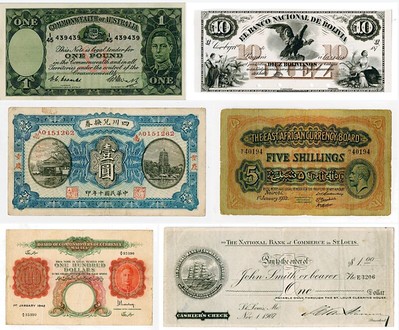
Something like this...
Before leaving their table David Gladfelter came by. I thanked him for his help with gathering back issues of the Garden State Numismatic Association's journal for future digitization on the Newman Numismatic Portal.
Pierre Fricke
Next I found paper money author and dealer Pierre Fricke examining a new purchase - and old-time album filled with obsolete banknotes. We snapped this photo with his phone.
Thanks.
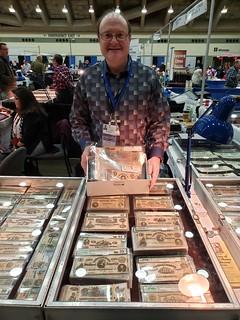
David Kahn
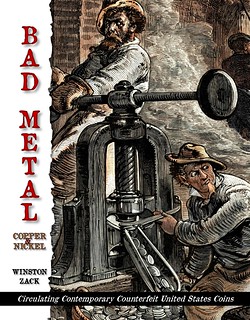 At the table of new E-Sylum advertiser David Kahn I met Dave and his daughter Melissa. There I was able to finally meet author Winston Zack and pick up a signed copy
of his new book on contemporary counterfeit coins. But in all the confusion I ended up walking away without paying for it! Good trick, but not one I want to become known for. I
contacted them after the show and made payment arrangements. I'm looking forward to reading it.
At the table of new E-Sylum advertiser David Kahn I met Dave and his daughter Melissa. There I was able to finally meet author Winston Zack and pick up a signed copy
of his new book on contemporary counterfeit coins. But in all the confusion I ended up walking away without paying for it! Good trick, but not one I want to become known for. I
contacted them after the show and made payment arrangements. I'm looking forward to reading it.
John Kraljevich
John Kraljevich was looking good and making deals at his crowded table. We caught up on life in general and his recent work on the 2020 Presidential campaign.
Erik Goldstein of Colonial Williamsburg was at the table, and we talked about the numismatic gallery being planned to open in a couple years. A new museum annex has been constructed and is waiting to be filled. This will be a destination for all numismatists.
Also at JK's table was literature dealer David Fanning, who showed me his current publishing project which will be announced in the near future. We also talked about our mutual friend John W. Adams and the previous evening's sale of his landmark collection of Comitia Americana medals.
Bill Eckberg
Over at the Early American Coppers table I spoke with EAC President Bill Eckberg, a member of my Northern Virginia numismatic social group Nummis Nova (now retired in Florida). We
spoke about the upcoming 2020 Pittsburgh EAC convention and a project we're jointly working on with the Newman Numismatic Portal.
C4
The Colonial Coin Collectors Club was holding its annual convention in conjunction with the show, and the real party was at the C4 tables, where everyone congregated. I was very
pleased to finally meet in person longtime E-Sylum contributor Julia Casey.
It was here that I also met for the first time author Roger Moore, who kindly signed my copy of his Coins of Colonial Virginia book. I also had a long conversation with C4 President Jack Howes about archiving their photos and chat forum on the Newman Portal.
Others I spoke with were a mix of old and new friends, including Mike Packard, Ray Williams, Craig McDonald, Roger Siboni, Will Nipper, and C4 cofounder Jeff Rock. Across the way my old friend Bob Metzger was temporarily manning the table of Clem Schettino. It was so great to see everyone. I'm sorry I was unable to attend Thursday night's forum, where I understand Erik Goldstein and David McCarthy gave a great talk about their research on the origin of the Continental Dollars.
Northeast Numismatics
Over at the table of Northeast Numismatics, Chris Clements was on his computer while Tom Caldwell was closing a coin deal that took an unusual turn and produced the most
entertaining moment of the day. As I understand it, Tom's price for the wholesale lot was $10,000, and the dealer asked (and I'm not sure if he was joking) if Tom would
take $9,000. And Tom said, "I'll flip you for it - if you win it's $9,000, but if I win it's $11,000". Soon a coin was being flipped in the aisle in front of
the booth. Tom won, and a check was written for $11,000. There's an amount of randomness in the price of every deal, but this is the first time I've seen it decided on a
coin flip.
Jon Sullivan
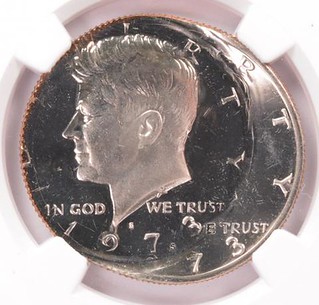
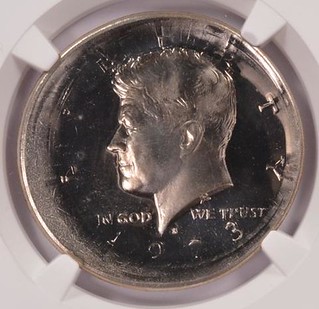
I enjoy error coins even though I don't actively collect them. So I stopped by the booth of error specialist Jon Sullivan who showed me a great array of error proof coinage that recently came to market.
Along came Steve Roach of Coin World, and Jon gave him a broadstruck piece he'd been holding for him. Then we all had a look at the broadstuck proof piece shown above at right.
For more information, or to order Jon's proof errors, see:
ngc 50c 1973-s proof kennedy half double-struck 25%
off-center pf66 cameo (https://www.sullivannumismatics.com/coin/ngc-50c-1973-s-proof-kennedy-half-double-struck-25-center-pf66-cameo?v=5434)
ngc 50c 1973-s proof kennedy half double-struck
broadstruck pf67 cameo (https://www.sullivannumismatics.com/coin/ngc-50c-1973-s-proof-kennedy-half-double-struck-broadstruck-pf67-cameo?v=5014)
Mark Anderson
My last stop in the bourse floor was unplanned, but delightful. I sat down for a long conversation with Mark Anderson of New York. We talked about the Newman Numismatic Portal,
the New York Numismatic Club. his father Burnette Anderson (the Washington correspondent for Numismatic News for many years), and money artist J.S.G. Boggs.
Dinner with Len and Deb
The time passed all too quickly and soon I was off to meet Len Augsburger in the lobby at 5:30. We walked over to Sullivan's restaurant where his wife Debra Kurtz joined us.
We ordered steak dinners and the meals were marvelous. The waitstaff was attentive and we had a very enjoyable evening talking about family life, today's show, the Newman
Portal and everything in between.
The Boston Banquet
Midway through our dinner, in walked another group of numismatic friends, (mostly) Bostonians: John and Regina Adams, Regina's son Jean, Charlie Davis, Neil and CJ Musante,
Anne Bentley, and David Fanning. Before leaving we stopped by their table to say hello.
John's Comitia Americana medal collection had been a highlight of the show's auctions. He was sorry to see his old friends go, but pleased with the overall outcome. It was great to see John, Regina and everyone.
... and More
Before ending my diary I should mention that I spoke with a number of other people as well, including Don Kagin and Julian Leidman.
People I missed because they'd either left the show or been busy when I passed their table included Dave Bowers, Tony Terranova, Harry Laibstain, Doug Winter, Gerry Fortin. Dave Perkins, Joe Lang at Stephen Album Rare Coins, Daniel Frank Sedwick and Augi Garcia at the Sedwick booth and Wayne Herndon.
It was a short walk from Sullivan's back to the Hyatt garage where I'd parked. In about an hour I was safely home. My knees were sore from being on my feet most of the afternoon. But it had been a delightful day - it was great to see so many friends and make some new ones. 'Til next time, everyone.

MET PUTS RARE COINS FROM NISHAPUR ONLINE
Helen Goldenberg from the Islamic Department of The Metropolitan Museum of Art writes:
"We recently published an essay on our Heilbrunn Timeline of Art History on a selection of rare coins excavated at the city of Nishapur by the MET in the 1930's and 40's. As you may know, these are only a fraction of our extensive collection of over 600 coins from this excavation in the MET's collection. We would like to announce the publication of this timeline essay to the community of scholars and collectors of Islamic coins."
Thanks to David Yoon for suggesting publication here in The E-Sylum. Here's the project description with a link to the site. -Editor
Rare Coins from Nishapur in the Collection of the Metropolitan Museum of Art
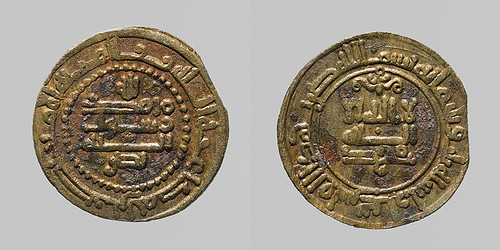
This new Timeline essay focuses on a group of rare coins excavated at Nishapur in northeastern Iran between 1935 and 1948 by the Metropolitan Museum of Art in partnership with the Iranian government. The two countries divided the finds, which resulted in the addition of 636 early and medieval gold, silver and copper Islamic coins from the eighth to the fourteenth century to the MET's collection. Thanks to the expertise of Abdullah Ghouchani, a numismatist and gifted epigrapher who spent most of his career working at the National Museum and teaching at Tehran University, the whole of the Met's collection has now been catalogued and is available, complete with inscriptions (when legible), on the museum's website.
Although segments of the Nishapur collection, such as ceramics, metalwork and glass have been published by excavators and scholars, the coins had never been properly documented or published. As a mine of rich historical, cultural and economic information about the medieval mercantile city of Nishapur, the coins shed new light on the city's importance as hub of trade on the Silk Road.
Due to the generous support of the Roshan Cultural Heritage Institute, the coins of Nishapur are now published online. Their availability helps amplify our understanding of the material culture of this crucial city, whose ceramics, glass, metalwork and wall paintings are also available in online catalogues on the Met's website.
Here is an excerpt from an essay on the site by Abdullah Ghouchani of the National Museum of Iran and Sheila Canby of the Department of Islamic Art, The Metropolitan Museum of Art. -Editor
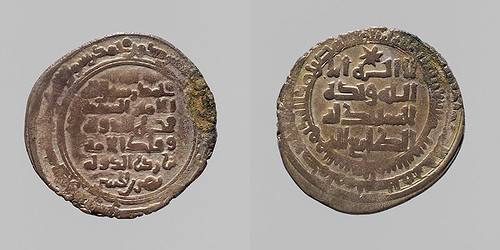
What makes an early Islamic coin rare? You might think that just by virtue of dating from the eighth or ninth century and being found in northeastern Iran, a coin would be exceptional. Yet, of the more than 1,200 early coins excavated at Nishapur during the 1930s and '40s by The Metropolitan Museum of Art in collaboration with the Iranian government, only thirty-seven of them would be considered rare. Some were minted in places from which few early Islamic coins are known, and others bear the names of governors or other rulers better known from historical texts than coins. Although the city of Nishapur in Khurasan is rightly celebrated for its ceramics, glass, and metalwork of the Samanid period (ca. 819–1005), the significance of the city as a center of trade from the eighth to the fourteenth century is most directly reflected in the coins. According to their agreement, Iran and The Met divided the finds, resulting in more than 5,000 objects entering the collection. The study of Islamic coins from Nishapur follows publications of the city's early and medieval Islamic ceramics, glass, metalwork, and architecture.
The Arab conquest of the lands from Spain to Iran in the seventh and eighth centuries opened trade routes between the former Byzantine and Sasanian regions united under the Umayyad and then Abbasid caliphates. Along with the exchange of goods, coinage circulated widely. Some of the rarest coins traveled a great distance before ultimately ending up in the ground at Nishapur. While we can only imagine how a particular coin found its way there, the names of individuals on the coins shed light on the political situation of their time. The coins come in three types: gold, silver, and copper, called dinar, dirham, and fals in Arabic. Whereas the names of Abbasid caliphs (temporal and spiritual leaders of the Muslim community) and overlords appear on silver and gold coins, copper coins bear the names of leaders of lesser rank as a form of acknowledgment of their rule. Additionally, mint marks indicate where the coins were struck.

To visit the online exhibit, see:
Rare Coins from Nishapur (https://www.metmuseum.org/toah/hd/rcnp/hd_rcnp.htm)

THE LIBERIA DOE COIN
Last week bloggers from the National Numismatic Collection at the Smithsonian highlighted the history of Liberia numismatics. Extending the story to the present, a November 11, 2019 article in the Daily Observer of Liberia discusses the legal standing of a modern coin and banknote. -Editor

It is common knowledge that only a constitutionally elected government has mandate to print new currencies or mint new coins for use by the people of a country which gave such Government the authority at the polls during General Elections. Thus, was the ‘LIBERTY' Five Liberian Dollars Bank Note, printed by the Interim Government of National Unity (IGNU) as well as the Five Liberian Dollars Coin, otherwise known as the "Doe Coin", minted by the Peoples Redemption Council (PRC) Government actually legal tenders in Liberia at the times of their respective printing and minting?
Let us now take a close look at Master Sergeant Samuel Kanyon Doe, who took the helm of power on April 12, 1990 by overthrowing Dr. William Richard Tolbert, Jr., through a bloody coup d'état. Head of State Samuel K. Doe, two years after his take over as junta leader, minted the "Doe Coin" in 1982 and put it into circulation against the United States Dollars which was unopposed. What significant impact then, did the "Doe Coin" have on the Liberian economy?
In my view, the "Doe Coin" played a major role in shifting the Liberian economy in contrast to the "Liberty" Bank note of Dr. Sawyer, even though it did not receive a constitutional mandate. For during the circulation of the "Doe Coin" on the Liberian Market, Liberia saw massive speedy growth in term of infrastructure, as well as economic and social development. There was the construction of the Samuel K. Doe Sports Complex previously initiated by President Tolbert, the Central Bank of Liberia, the Ministry of National Defense, etc. What then about Dr. Amos C. Sawyer's "Liberty" Bank note? What impact did it make?
The bottom line is that neither did Samuel Doe have the right to mint coin, nor Dr. Sawyer the right to print new banknote in the absence of constitutional mandate.
To read the complete article, see:
Were The "Doe Coin" and ‘Liberty' Bank Note Legal Tenders in
Liberia? (https://www.liberianobserver.com/opinion/were-the-doe-coin-and-liberty-bank-note-legal-tenders-in-liberia/)
To read the earlier E-Sylum article, see:
NUMISMATICS IN LIBERIA (https://www.coinbooks.org/v22/esylum_v22n45a22.html)

FANTASY TOKEN DIES EMERGE
Adrian Lansen submitted this article on behalf of Gary Oddie about modern forgery dies, including an interesting fake Dutch East Indies plantation token. Thank you. -Editor
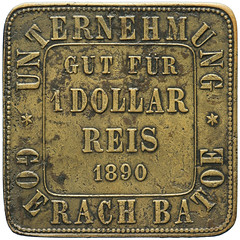
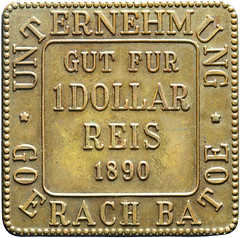
LEFT: Genuine token; RIGHT: Fake token
A Group of Dies for Fantasy Tokens
Gary Oddie
Recently a group of seven dies appeared on the market. Four of the dies form a group that produced fantasy transport tokens sometime between 1967 and 1990. Two dies produced a fantasy transport token sometime between 1990 and 2016. The final die was used to produce a previously unrecognised fantasy tobacco plantation token from the Dutch East Indies.
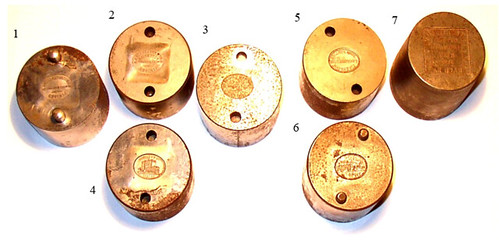
Each die is illustrated and a separate image of the die face is shown along with a mirrored image and a specimen of the token.
#1 LEICESTERSHIRE STREET RAILWAY CO LIMITED

The die is cylindrical, diameter 64.6 mm, height 50.2 mm, with a very smooth outer surface. Two steel dowels protrude from the die face to locate opposing die. This is the obverse die of a fantasy token listed as Leicestershire 451YA in Smith and Smith(1).
#2 STAFFORDSHIRE POTTERIES STREET RAILWAY CO LIMITED

The die is cylindrical, diameter 64.2 mm at the die face and 64.3 at the base, height 47.3 mm, with a rough lathed outer surface and a small step at half height. Two holes are present to receive dowels from the opposing die. This is the obverse die of a fantasy token listed as Stoke-on-Trent 730YA in Smith and Smith(1).
#3 WARWICKSHIRE STREET RAILWAY CO LIMITED

The die is cylindrical, diameter 64.6 mm, height 52.2 mm, with a very smooth outer surface. Two holes are present to receive dowels from the opposing die. This is the obverse die of a fantasy token listed as Warwickshire 823YA in Smith and Smith(1).
#4 TRAIN'S PATENT around a horsecar and Marble Arch

The die is cylindrical, diameter 64.4 mm at the die face and 64.3 at the base, height 46.3 mm, with a rough lathed outer surface and a small step at half height. Two holes are present to receive dowels from the opposing die. This is the reverse die of a fantasy token listed as; Leicestershire 451YA, Stoke-on-Trent 730YA and Warwickshire 823YA in Smith and Smith(1).
There is a characteristic oval die flaw in the outer rim(2) which gives away the method of manufacture as a CNC milling machine. This also explains the letter forms and sans serif fonts. When looking closely at the die, the crescent shaped milling marks can be seen

#5 JOHN PHILIPS PROPRIETOR LIVERPOOL

The die is cylindrical, diameter 64.6 mm, height 55.6 mm, with a very smooth outer surface. Two holes are present to receive dowels from the opposing die. This is the obverse die of a fantasy token copying Smith and Smith 470D(1). Not catalogued in 1990, but noted in 2013(2).
#6 CITY OMNIBUS a horse car with driver and passengers

The die is cylindrical, diameter 64.6 mm, height 55.6 mm, with a very smooth outer surface. Two steel dowels protrude from the die face to locate opposing die. This is the reverse die of a fantasy token copying Smith and Smith 470D(1). Not catalogued in 1990, but noted in 2013(2).
#7 UNTERNEHMUNG GOERACH BATOE around GUT FUR 1 DOLLAR REIS 1890
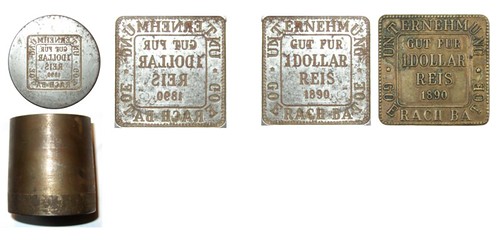
The die has a cylindrical base with a very smooth outer surface, 64.6 mm diameter. This has been lathed to taper to 59.8 mm at the die face. The die is 71.5 mm high. This is a plantation token of the Dutch East Indies (LaBe 87(3), LaWe 96(4)) and has been listed as a pattern in the most recent catalogue, even appearing on the front cover(3). All known specimens of the token are uniface.
The Lansen specimen was sold at auction in 2012(5). The piece can be distinguished from the official issue by the stars in the legend (5 rather than 6 points) and the serif on the "1" (short and slightly sloping rather than long and steeply sloping). A more recent website warns of "modern forgeries" of the plantation money of the Dutch East Indies but gives no more details(7).
Conclusions
The first four dies provide a complete set for three fantasy transport tokens that were not listed in the 1967 book by Smith(6) but had been catalogued in 1990 by Smith and Smith(1). These pieces regularly appear on the market, and though their fantasy status is known(1,6) it is rarely mentioned.
Dies 5 and 6 produced another fantasy transport token not known in 1990(1), but noted in 2013(2).
It is highly likely that the plantation token from the Dutch East Indies is also a previously unrecognised fantasy piece from the same source. It appears to be cut from the same steel bar as the transport tokens (diameter and surface finish) and dates to a century later than the official plantation token issue.
As might be expected the dies have no provenance but is likely that other dies will exist from the same source.
References and Acknowledgements
(1) K.E. Smith and K.S. Smith. Catalogue of world Horsecar, Horseomnibus, Streetcar, and Bus Transportation Tokens Except North America. 1st Edition, American Vecturist
Association. 1990.
(2) http://www.worldofcoins.eu/forum/index.php?topic=24162.0 Accessed 20th October 2019.
(3) A.J. Lansen and M.L.F. van der Beek: Plantation Tokens of the Dutch East Indies. Private Print, Ijsselstein 2018.
(4) A.J. Lansen and L.T. Wells Jr. Plantage-, Handels-, en Mijngeld van Nederlands-Indie, 2001.
(5) Baldwins Auctions. No 74. The A.J. Lansen Collection of Plantation tokens etc. Lot 1096. 9 May 2012.
(6) K.E. Smith. Catalogue of World Transportation Tokens and Passes except North America. 1st Edition. American Vecturist Association. 1967.
(7) http://www.plantagegeld.nl/index.php?paginaid=14 Accessed 20th October 2019.
Many thanks to Malcolm Johnson for useful comments and permission to use images from the World of Coins Forum.
To read two papers on the site of the British Numismatic Society, see:
A Group of Dies for Fantasy Tokens
(https://britnumsoc.files.wordpress.com/2019/10/42-counterfeit-token-dies-003.pdf)
Further Notes on a False Plantation Token
(https://britnumsoc.files.wordpress.com/2019/11/45-counterfeit-token-dies-101.pdf)

THE SUNOCO ANTIQUE CAR COIN COLLECTION
Phil Iversen writes:
"I read the article in last week's issue of The E-Sylum about the Studebaker coin and it reminded me of my stay in Denver for the 2017 ANA convention. I stayed at a place a few blocks from the main downtown library and history museum and one day while driving around the area I noticed an old building as shown in the attached photographs. I can only presume that this was a showroom that sold both brands of cars as engraved on the front of the building."

The Franklin-Studebaker Denver Showroom
I was unaware of the Franklin Automobile Company. Founded in 1902, it failed in 1934, which could help date the building.
I looked for a Franklin Automobile medal, but the only numismatic item I could quickly locate was this Sunoco Antique Car Coin Series piece found on Numista. I'm old enough to remember these, which came out when I was around eleven years old. If I remember correctly, you'd get one each time you filled your gas tank at a Sunoco station and could attempt to collect the whole set. -Editor

https://en.numista.com/catalogue/pieces75570.html
I found more information on the series on David W. Boitnott's Coin-n-Medal Collectors' Asylum site. -Editor
Introduced in 1969, one year after Shell Oil Company's very successful "Mr. President" promotional coin game, Sunoco's "Collection of Antique Car Coins" was the first true collector's promotion. This promotion was based on the 75-medal Franklin Mint "Collection of Antique Car Coins" that was produced over two years and in three 25-medal sub series. Sunoco would only utilized the first two of the three 25-medal series. This exhibit will focus on Series 1. The promotion did include coins with special "instant winner" reverses like the Shell games; however, unlike the Shell games the two 25-coin sets were not broken up into prize groups with low mintage keys that had to be turned in to claim the prize making them unobtainable today. This meant one had a reasonable chance of actually assembling the aluminum set through continued patronage of their local Sunoco service station.
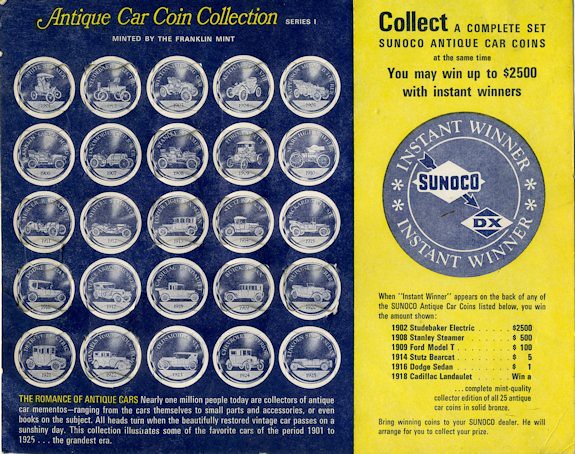
Struck by the Franklin Mint in 1969, the aluminum "Collection of Antique Car" coins were distributed through the Sun Oil Company (Sunoco) as a promotion at their service stations. The "Collection" was split into two series of 25 coins each distinguishable by their reverses. The 26 mm in diameter Series 1 aluminum game coins featured a reverse with "ANTIQUE CAR" on top and "COIN SERIES 1" on the bottom around the periphery and two Sunoco trademarks – first the Sunoco sign with arrow and the second the DX diamond used on their brand of motor oil in the center. Both series of the "Collection of Antique Car" coins can be found in Krause Guidebook of Franklin Mint Issues (multiple editions) under the Franklin Mint catalog code ACG.
The aluminum game pieces:
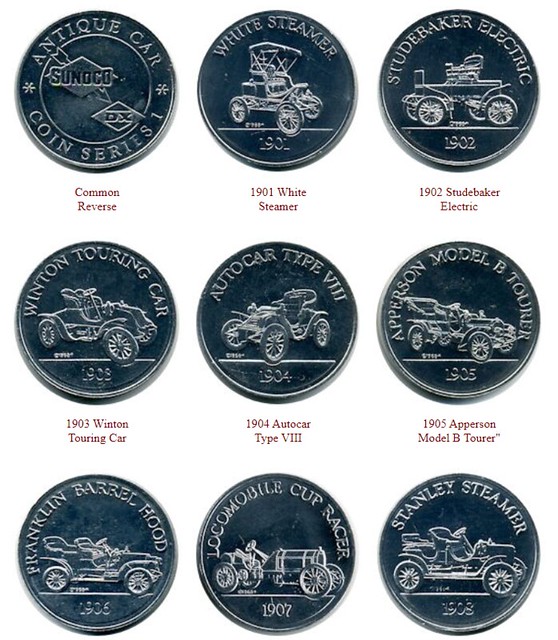
To read the complete article, see:
SUNOCO COIN PROMOTIONS
(http://www.coins-n-medals.com/Exhibits/SunocoCoins/antiqueCars1.html)
I hadn't come across this web site before. It proclaims, "Welcome to the Asylum for the Numismatically Insane. Devoted to Promoting the "Lunacy" We Call Coin Collecting" -Editor
To read the earlier E-Sylum article, see:
NUMISMATIC NUGGETS: NOVEMBER 10, 2019 : 1952 Studebaker Centennial Medal
(https://www.coinbooks.org/v22/esylum_v22n45a21.html)
THE ATLANTIC CABLE MEDAL OF 1866
Last week we briefly discussed an 1866 Atlantic Telegraph Cable Medal. Herman Blanton wrote about these in the July 2006 issue of The Numismatist, and there is also a version of his research on the Atlantic Cable website. Herman kindly sent a link and gave us permission to publish an excerpt here. Thanks! There is much more information on the web site, so be sure to follow the link. -Editor
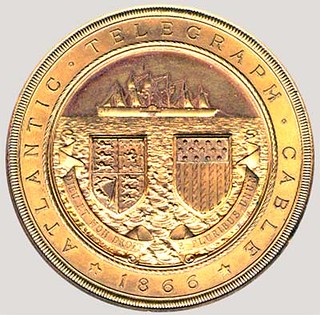
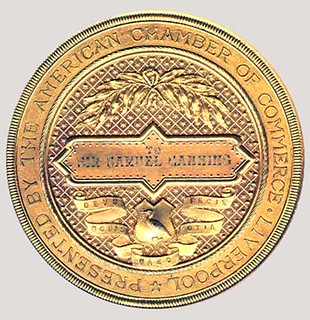
Medal given to chief engineer Samuel Canning
The completion of the Transatlantic Cable in 1866 is an important milestone in history, especially the history of communication. The cable made it possible for North America and Europe to be connected telegraphically for comparatively instant communication, news could henceforth be transmitted between continents in a matter of a few minutes instead of 10 days each way for transatlantic ship passage. The year 2006 marks the 140th anniversary of the successful laying of the cable. The subject medal was presented in 1867 to show appreciation for the efforts spent and risks taken to complete the task.
The transatlantic cable was the dream of more than a single person, but no one person stands out more than Cyrus Field as the driving force behind the project to develop and install the transatlantic cable. In 19th century parlance, Field is referred to as the "projector" of the cable. In this article we only touch on the history of the project as our interest is primarily about a commemorative medal issued for it. For history of the transatlantic cable see the bibliography for suggested reading.
The 1857 & 1858 Cables
The first attempt at a transatlantic cable was in 1857 as a joint enterprise between England and the United States. Twenty five hundred nautical miles of cable was designed, manufactured and loaded upon two ships, as no single ship was able to handle such a great load. The engineers / scientists among the expedition included Charles Bright, William Thomson (later Lord Kelvin), Edward Whitehouse and Samuel Morse. Starting from Valentia Bay Ireland, they laid four hundred miles of cable before it broke and vanished under the sea. Cyrus Field signaled the ships of the expedition to meet, to discuss the matter, review what had been learned so far and do experiments; afterwards they returned to England. The cost of the failed expedition was £225,000 (about £14,000,000 today), but Field was not deterred.
A second expedition in 1858 led to a successful transmission from Queen Victoria to President Buchanan, but within a month the cable failed completely. -Editor
The Great Eastern
Before another attempt to lay a cable could be made, the US Civil War erupted putting the project on hold, it would be 1865 before another expedition was started. In the meantime the world's largest ship was completed in 1858 and put into service, the Leviathan, renamed the Great Eastern. She was the largest ship ever built until that time, dwarfing every other ship afloat. Designed by Isambard Kingdom Brunel to be the greatest ship ever made, it proved to be too far ahead of its time to be a commercial success, and was converted from a passenger/mail liner to a "cable ship." "She was six times larger than any previous ship. Nearly 700 feet (213 m) long and 82 feet (25 m) broad, she would carry 4,000 passengers (or 10,000 soldiers as a troopship) and 6,000 tons of cargo."
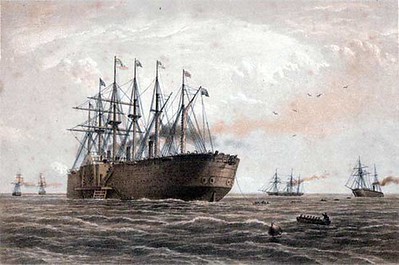
The Great Eastern with escort and other ships
An expedition in 1865 ended in failure as well. This was no easy task, and required tremendous investment, patience and fortitude. -Editor
The 1866 Cable
Learning from the 1865 expedition, changes were made in the cable design, to the cable paying out machine and to the Great Eastern itself. With these changes the crew could retrieve the cable by running the paying-out machine in reverse without snagging the cable in the ship's propeller.
With the shore end of the cable landed in Ireland, the Great Eastern started out on the inauspicious day of July 13th 1866, a Friday. The chief engineer was Samuel Canning, the chief electrician Willoughby Smith and consultant William Thomson. By Tuesday the 24th of July, the Great Eastern had passed the point where the 1865 cable had broken; traveling 60 miles to the south of it, for the expedition had plans to retrieve the 1865 cable and did not want the two cables close to each other for the grappling procedure. On July 27th, 1866 the cable was spliced with the shore-end at Heart's Content Newfoundland, the cable was laid.
The successful completion of the cable was met which much celebration and recognition in England and the United States. One of the celebrations was the awarding of a gold medal, in Liverpool, the subject of this article.
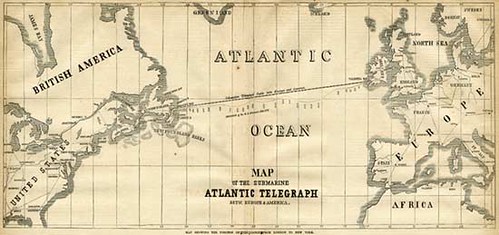
"The medal, of which we give an Illustration, was designed and manufactured by Mr. Wyon. It is of solid gold, weighing more than three quarters of a pound. On one side is represented the Great Eastern steam-ship, in full sail upon the ocean, encircled by the words "Atlantic Telegraph Cable," with the heraldic arms and legends of the kingdom of Great Britain and of the United States of America beneath the ship. On the reverse side is engraved in a scroll cut specially for each of the four gold medals the name of the gentleman to whom it is given, below which are the arms and legend of the town of Liverpool."
The Atlantic Medal
The four gold Atlantic Cable medals were made by the firm J.S. and A.B. Wyon of 287 Regent St. London. This is the address noted in the correspondence; the address imprinted inside the medal case is "2 Lanham Chambers, London, W." Joseph Shepherd Wyon and Alfred Benjamin Wyon were brothers, members of the famous Wyon family of medallists and engravers.
A first hand examination of the medal shows it to be bronze with a heavy gold plating, gilt, not solid gold. The medal is 76 mm in diameter, which is 3 inches. The edge is plain and the alignment is what is referred to as "medal alignment" in the US, if rotated on 12 to 6 o'clock axis, both the obverse and reverse are upright. The medal weighs 206.8 grams, (7.29 oz avoirdupois, 6.50 oz troy). If the same size medal were of 22k gold it would weigh approximately 432 grams (15.4 oz avoirdupois, 13.9 ounces troy) using relative density of bronze 8600 kg/cubic meter and gold at 19320 kg/cubic meter. There is no apparent correlation of the medal's weight with the Illustrated London News account, curiously however, the medal with case weighs 12 ounces avoirdupois, which is three quarters of a pound.
In addition to the four gold medals recorded in the documentation there is a silvered medal, without engraved name on reverse, possibly a trial strike, in the collection of the National Maritime Museum in Greenwich England. The medal is cataloged as number MEC1293 and illustrated on the museum's Web site.
To read the complete article, see:
The Atlantic Cable Medal of 1866 (https://atlantic-cable.com/Souvenirs/1866Medal/index.htm)
To read the earlier E-Sylum article, see:
NUMISMATIC NUGGETS: NOVEMBER 10, 2019 : Atlantic Telegraph Cable Medal
(https://www.coinbooks.org/v22/esylum_v22n45a21.html)

ANIMALS MEDAL OF BRAVERY CREATED
In the why-didn't-I-think-of-that department, a new medal has been created in the U.S. modeled after the U.K.'s Dickin medal for gallantry in animals. The Washington Post reported on the inaugural award ceremony this week on Capitol Hill. -Editor
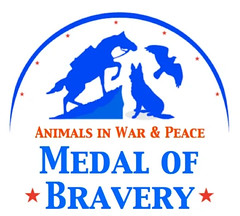 Capitol Hill is divided these days. Impeachment hearings are leaving public servants cast as spies and saviors, connivers and guardians.
Capitol Hill is divided these days. Impeachment hearings are leaving public servants cast as spies and saviors, connivers and guardians.
Perhaps that is why applause for a stuffed pigeon in a plexiglass case in a House building seemed particularly vigorous on Thursday evening. The bird has been dead for 58 years, but during World War II, he saved more than 100 Allied soldiers by flying 20 miles in 20 minutes to deliver a message that aborted an imminent bombing by friendly forces. His name was GI Joe, and he was one of the eight recipients of a new charity-sponsored medal of bravery for American war animals.
Organizers, members of Congress and animal handlers present said the awards were long overdue. Some called it a historic day. A few wept. One of GI Joe's postwar caretakers — who said the pigeon's speed on that fateful day probably was assisted by a tail wind — teared up as he patted the bird's case. Now, as then, GI Joe did not waver.

Against the backdrop of impeachment, that theme stood out: No matter that the honored animals — five dogs, two pigeons and one horse — almost certainly did not know their nation's mission or enemies. They knew their jobs and did them with nary a peep, bark or neigh. Some speakers mused about why the animals acted bravely, citing loyalty to pack, adoration for handlers, and programming by training. Everyone said they were heroes.
"Let the record show: Sergeant Reckless was a lot more courageous than I," former senator John W. Warner (R-Va.), a Korean War veteran, said of a horse who served in that war.
Reckless knew to run for cover during incoming fire, shared tents with fellow Marines, enjoyed beer and bacon, and most important, carried 9,000 pounds of ammunition in 51 round trips over steep, frozen hills during the 1953 Battle for Outpost Vegas. The mare was later named a staff sergeant by the Marine Corps commandant.
Animals have served in battles for as long as war has been waged. Dogs are most common now, but Hannibal used elephants, Genghis Khan rode horses, and the U.S. military has recruited bats, dolphins and chickens. Since 1943, an animal welfare charity in the United Kingdom has awarded the Dickin Medal, roughly equivalent to the Victoria Cross, to war animals. But while Reckless received two Purple Hearts, there's not much pomp these days for nonhuman veterans on this side of the Atlantic.
Hutton said she got the idea for the awards — officially called the "Animals in War & Peace Medal of Bravery" — after accepting a Dickin Medal on Reckless's behalf in 2016 and wondering why such an honor didn't exist in the United States. Her goal is to open an international war animals museum in the Washington region and give medals annually. The event was sponsored by her charity, Angels Without Wings, and the National Marine Corps League.

In addition to Reckless and GI Joe, other animals posthumously given medals were Chips, a pet husky mix whose family volunteered him for service in World War II; Stormy, a German shepherd who helped capture enemy soldiers during the Vietnam War; Lucca, who lost her left front leg to one of the many roadside bombs she detected in Afghanistan.
Also honored was Cher Ami, a World War I pigeon shot down by Germans while carrying a crucial message ...
Bucca, a former stray who overcame a rough past to become a star arson-detecting K-9 for the New York Fire Department, glanced around the room as her handler placed the shiny golden medal around her neck.
Great idea - it's high time for U.S. animal heroes to receive their due. -Editor
To read the complete article, see:
U.S. animals now have a medal for wartime bravery
(https://www.washingtonpost.com/science/2019/11/15/us-animals-now-have-medal-wartime-bravery/)
The article and web site (linked below) don't have any numismatic details on the medal itself. The right is a cropped image from the Washington Post article. The box indicates it is from insignia makers Cleave of London. I'll reach out and try to learn more. -Editor
For more information, see:
HONORING ANIMALS THAT HAVE SERVED OUR COUNTRY IN WAR & PEACE (https://waranimals.com/medal-of-bravery)
ROYAL ENGINEERS MUSEUM DISPLAYS VICTORIA CROSS
Here's a fascinating story about a Victoria Cross medal awarded to a British soldier following the recommendation of the German commander he valiantly fought to his death. -Editor
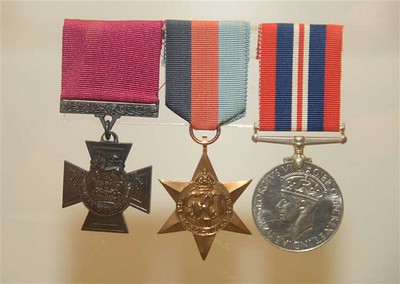
A Victoria Cross awarded to a sergeant after he was recommended for it by a German commander, is displayed in the Royal Engineers Museum in Gillingham.
Sgt Thomas Frank Durrant, 23, was awarded the Victoria Cross after his efforts in a raid on St Nazaire, France, on 28 March, 1942.
Sgt Durrant was part of the No 1 Commando unit which was tasked with the destruction of a Normandie dry dock. This would force any large German warships in need of repair to return to home waters, rather than seek safe haven on the Atlantic coast.
While positioned by the Lewis gun on board the HM Motor Launch 306 during the raid, Sgt Durrant refused to leave his post, despite being shot in the arm. En route to St Nazaire on the River Loire, his vessel was attacked by the German torpedo boat, Jaguar.
Sgt Durrant drew enemy fire to himself after the searchlight fell on the Launch, sustaining further severe wounds to the arms, legs and chest. By this point, the only way he could support himself was by leaning on his gun.
When the German commander demanded the ship's surrender, Sgt Durrant again refused to leave his post, even after the Motor Launch was boarded and captured.
Sgt Durrant died from his wounds several days after the raid. However, the German commander came across the captured British commander a week later and mentioned Sgt Durrant's actions during the raid, suggesting that he should be put forward for the Victoria Cross.
The medal was presented by King George VI to Sgt Durrant's mother at Buckingham Palace on October 29, 1946.
Danielle Sellers, 41, collections manager at the Royal Engineers Museum, said: "The medal was loaned to the Royal Engineers Museum in the 1950s and eventually got gifted to the museum in 2009. This was given to the museum as Durrant was a Royal Engineer, so his family thought it would be a good home for his medal."
To read the complete article, see:
Royal Engineers Museum displays unique Victoria Cross from British
Sergeant (https://www.kentonline.co.uk/medway/news/german-recommended-british-sgt-for-victoria-cross-215773/)
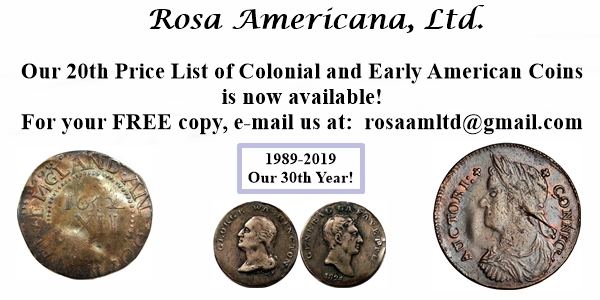
HOW THE NOBEL MEDALS ARE MADE
Joe Esposito writes:
Thanks. Here's an excerpt. -Editor
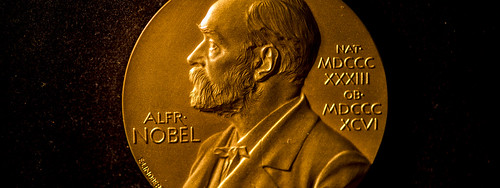
Since 1901, the Nobel Prize medals have been part of many remarkable stories. Three Nobel medals had to be dissolved in Denmark to keep them hidden from the Nazis. Two Nobel medals were mixed up between different laureates and it subsequently took them four years to correct the mistake. One Nobel medal caused confusion at airport security as it turned up completely black in the X-ray machine in Fargo, North Dakota. This is, to say the least, a very special gold medal.
In 1902, the Laureates received the first "real" Nobel Prize medals for Physics, Chemistry, Physiology or Medicine and Literature designed by the Swedish sculptor and engraver Erik Lindberg. Then you might ask why not since 1901, when the first Prizes were awarded? The reason for the delay was because the designs of the reverse sides of the "Swedish" Nobel medals were not finalized in time for the first Award Ceremony in 1901. The designs needed to be approved by each Prize-awarding institution.
From Erik Lindberg's correspondence with his father Professor Adolf Lindberg, it seems as if each of the 1901 Laureates received a "temporary" medal – a medal bearing the portrait of Alfred Nobel, struck in a baser metal – as a memento until the "real" medals were finished. The first of these medals were not completed and struck until September 1902.
The web page includes a great gallery of photos; here are a few. See the complete article online for more. -Editor
See how the Nobel Medals are manufactured

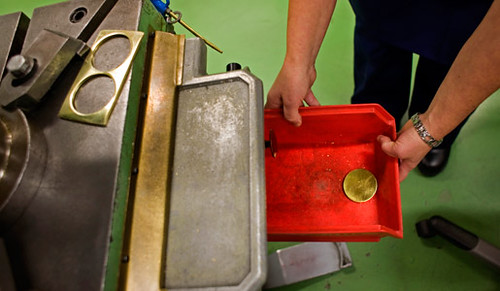
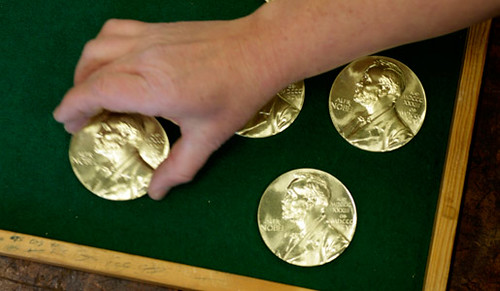
To read the complete articles, see:
A unique gold medal
(https://www.nobelprize.org/prizes/about/the-nobel-medals-and-the-medal-for-the-prize-in-economic-sciences/)
A work of art in the form of a diploma (https://www.nobelprize.org/prizes/about/the-nobel-diplomas)

EMPEROR NORTON 50 CENT BOND DISCOVERED
John Lumea of San Francisco runs The Emperor's Bridge Campaign, which promotes the memory of the beloved eccentric Joshua Norton, who declared himself "Emperor of the United States and Protector of Mexico". In his email CAMPAIGN NOTE No. 63 on November 4th, 2019, he announced a numismatic discovery. -Editor
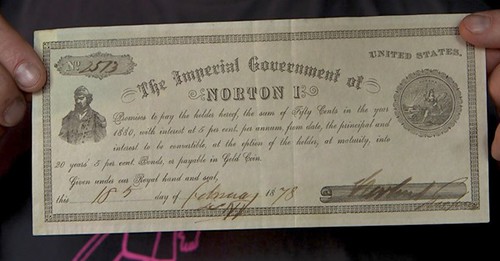
Emperor's Bridge Campaign in Coverage of Newly "Discovered" Emperor Norton Note In a fabulous good-luck story, our good friend, Emperor Norton's Boozeland co-owner Kevin DeMattia, was able to buy — for a thousand bucks — what now is regarded as one of the finest examples of one of the 40 Emperor Norton treasury notes known to exist: a note that, on the collectors' market, would fetch $12,000–$15,000.
Some backstory...
It was on 6 February 2018 — the day before the Campaign's big February 7th splash for the Emperor's 200th birthday, at the Mechanics' Institute — an event attended by Joe Rosato of NBC Bay Area — that Kevin first messaged me about an out-of-the-blue offer he had received from someone in Oregon, to sell him an Emperor Norton note from February 1878.
Over the last few years, various numismatists — experts in the history and collecting of rare currency and coin — have flagged my research and writing about Emperor Norton notes, in their newsletters and auction listings.* So, the day after the bicentennial celebration, I put out feelers among my contacts in the numismatics community.
Donald Kagin of Kagin's, Inc. — just across the Golden Gate, in Tiburon, Calif. — is one of the country's most respected historians and dealers in rare currency. He specializes in Western Americana and has carved out an expertise in Norton notes.
On 20 February 2016, I introduced Kevin and Don via email — and the rest, as they say....
It's great to see a happy ending to this story. I connected John with Don Kagin back in April 2018 when this note first surfaced. I'm happy to learn it turned out to be genuine. Here's an excerpt from one of the media stories about it. -Editor
True Norton-handled items are exceedingly rare and valuable, as they're more than a hundred years old and so very few survived the 1906 earthquake and fires. But a priceless Norton relic has just turned up, and you can go see it right now, as NBC Bay Area reports that the bar Emperor Norton's Boozeland on Larkin has acquired an authentic Emperor Norton promissory note, which has been authenticated as legit, and appraised as being worth $15,000.
Emperor Norton, of course, handed out the notes as his own handmade currency in the 1860s and 70s. With a face value of 50 cents on the day the Emperor signed them, these notes now fetch five figures among collectors.
"I decided to buy it sight unseen and sans authentication," Emperor Norton's Boozeland owner Kevin DeMattia told NBC Bay Area. DeMattia has all manner of Emperor Norton ephemera on display at his bar, from murals to sculptures to ‘Don't Call it Frisco' signs, but the only Emperor Norton currency he's ever had was a replica. "They were printed by the thousands, but then the Great Fire came through and burned everything, so they went from everyone had one to no one had one," he said.
The bill's authenticity has been verified, thanks to the efforts of the Emperor's Bridge Campaign that has long sought to add "Emperor Norton Bridge" as a name for the San Francisco-Oakland Bay Bridge. "Kevin first messaged me about an out-of-the-blue offer to purchase an Emperor Norton note from February 1878," campaign president John Lumea writes in the Facebook post above. "I put out feelers among my contacts in the numismatics community."
(By ‘numismatics' he means the study of currency from centuries past, and the expert brought in was Kagin's Inc. of Tiburon.)
Appraiser Don Kagin decreed that it was authentic, noting it was hand-numbered as 2573, is the fortieth known genuine surviving note. He valued it between $12,000 and $15,000, though its 1878 face value is but 50 cents.
Though a party celebrating the note already happened last weekend, you can pop in and check the note out at Emperor Norton's Boozeland, 510 Larkin Street (at Turk Street) from Noon to 2 a.m. every day.
To read the complete article, see:
Emperor Norton Bar Buys Emperor Norton Bond, Which Is Worth
$15,000 (https://sfist.com/2019/10/31/emperor-norton-bar-buys-emperor-norton-note-which-turns-out-to-be-worth-15-000/)
Be sure to watch the excellent video chronicling the entire authentication process. -Editor
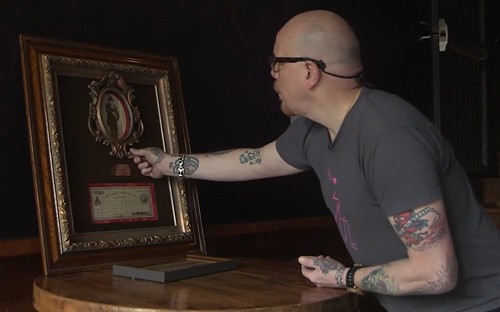
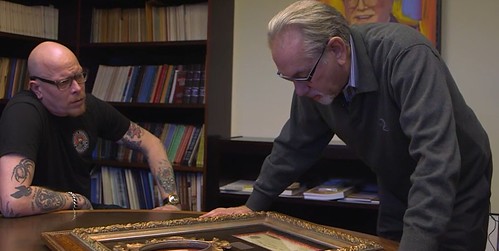
"Honey, I'm doing some numismatic research, I'll be at the bar at Emperor Norton's Boozeland." -Editor
To watch the complete video, see:
San Francisco Bar Owner
Discovers 141-Year-Old Bond Issued by Emperor Joshua Norton
(https://www.nbcbayarea.com/news/local/San-Francisco-Bar-Owner-Discovers-141-Year-Old-Bond-Issued-by-Emperor-Joshua-Norton-563861581.html)
THE BOOK BAZARRE
OLD GRADING HOLDER COLLECTION SURFACES
We've often discussed the collecting of old-style third-party grading coin slabs (both regular versions and sample slabs). Over on the CDN Publishing blog, GreatCollections announces the sale of a collection of coins encapsulated in old PCGS and NGC holders. -Editor
 GreatCollections is pleased to announce the Ultimate Collection of Rattlers and Old Holders. The collection comprises nearly 100 certified coins that were graded in the
early years of PCGS and NGC and have resided with one owner ever since.
GreatCollections is pleased to announce the Ultimate Collection of Rattlers and Old Holders. The collection comprises nearly 100 certified coins that were graded in the
early years of PCGS and NGC and have resided with one owner ever since.
The collection of important early U.S. coins includes a 1796 Draped Bust Quarter, graded PCGS MS-64 and a 1796 Draped Bust Dime, graded PCGS MS-63 – both encapsulated in small "rattler" holders, the original type by PCGS. NGC highlights include an 1885-CC Morgan Silver Dollar graded MS-68 with crescent toning and several low-mintage proof Seated Quarters, all in the original "fatty" holders.
Ian Russell, owner/president of GreatCollections said: "We often dream of finding an original hoard of old holders of this magnitude and our dream came true this time! The originality, quality and rarity of these coins are out of this world. 1797 Half Dollars are extremely rare, and this collection has two examples, both in rattlers.
"One of my favorite coins from the collection is the 1796 Draped Bust Dime. Conservatively graded MS-63 in the late 1980s, the coin exhibits original luster rarely encountered on 18th century U.S. coinage," Ian continued.
To read the complete article, see:
GreatCollections Offers the "Ultimate
Collection" of Rattlers and Old Holders at Unreserved Auction
(http://blog.greysheet.com/greatcollections-offers-the-ultimate-collection-of-rattlers-and-old-holders-at-unreserved-auction/)
Some of the old holders have new CAC stickers on them. So are they still old? Are they still collectible, or will slab aficionados turn up their noses because of the sticker? I reached out to David Schwager, author of the Sample Slabs catalog. -Editor
I was intrigued to see the Ultimate Collection of Rattlers and Old Holders. Great Collections has sold several high end slabs, such as the NGC black and PCGS Regency. This collection is in older holders, such as PCGS rattlers. But the slabs themselves, while early holders that often indicate quality coins, are not scarce enough to be collectible by themselves. This is less a collection of premium plastic than it is a collection of excellent coins housed in older holders.
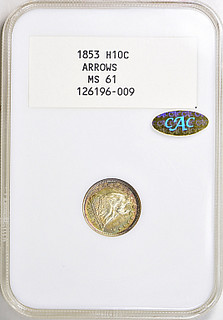 "The coin of most interest to slab collectors happens to be one of the least valuable pieces in the collection. An 1853 With Arrows half dime (NGC MS 61) is in a
white label NGC holder, an early type that earns a premium of about $200 over the value of the enclosed coin. The NGC price guide for this piece is $230, so a slab collector might
buy it at $400 or so. I know someone who avidly seeks NGC white labels and I'll let him know about it.
"The coin of most interest to slab collectors happens to be one of the least valuable pieces in the collection. An 1853 With Arrows half dime (NGC MS 61) is in a
white label NGC holder, an early type that earns a premium of about $200 over the value of the enclosed coin. The NGC price guide for this piece is $230, so a slab collector might
buy it at $400 or so. I know someone who avidly seeks NGC white labels and I'll let him know about it.
"On the question of CAC stickers on valuable slabs, they usually don't matter. CAC evaluates the coin and not the plastic. I would be equally happy with a scarce slab either without the sticker. And if I don't like the sticker, I can always peel it off."
Thanks. I'm not familiar with CAC stickers, but can they be removed that easily? Would they leave a mark on the holder? Removal should at least destroy the sticker, or shysters could slap them on lesser coins. -Editor

PALESTINE MANDATE BANKNOTES IN THIN SILVER
Mel Wacks submitted this article about facsimiles in silver of rare Palestine Mandate banknotes. Thanks. -Editor

Collectors who have dreamed of adding the extremely rare 50 and 100 Pound Palestine Mandate banknotes to their collections can now do so ? sort of ? at a tiny fraction of the over $100,000 they have been bringing. That's thanks to precise 150 x 70 mm. facsimiles produced in paper-thin, flexible pure silver with a weight of 5 grams by the Israel Coins and Medals Corp., an official distributor for the Bank of Israel.
The £50 note has sold for more than $100,000, and few bank notes from around the world come rarer than a Palestinian £100 ? only four are known to still exist.
The 1927 Currency Ordinance of the Palestine Currency Board specified the denominations of the new notes as 500 mils, £1, £5, £10, £50, and £100. These were designed and printed by Thomas de la Rue in England. The Palestine Mandate's charter from the League of Nations required that the name "Palestine" be shown in English, Arabic, and Hebrew. The structures appearing on the notes have significance for Jews, Muslims and Christians.
The 500 mil note pictures the Tomb of Rachel. Rachel was the second and favorite wife of Jacob, grandson of Abraham. During a journey from Shechem to Hebron, Rachel suffered a difficult labor while giving birth to their second son Benjamin: "And Rachel died, and was buried on the way to Ephrath, which is Bethlehem. And Jacob set a pillar upon her grave" (Genesis 35:19-20).
The front of the £5, £10, £50, and £100 Palestine Mandate notes feature a vignette of the Tower of Ramla. The tower was built in the 13th century by the Mamluk sultan al-Zahir Baybars to celebrate his eviction of the Crusaders from Ramla in 1268.
The front of the £1 note banknote pictures one of the most prominent features of Jerusalem ? The Dome of the Rock. This important Muslim mosque stands atop the ancient Jewish Temple Mount, the holiest Jewish site ? where Abraham was ordered to sacrifice Isaac.

The vignette on the back of all six denominations shows the Citadel and Tower of David. It is one of Jerusalem's most prominent landmarks, forming part of the Western Wall of the Old City. It was built on the site believed to have been that of a fortress built by King David.
The Citadel in various forms had long been part of Jerusalem's fortifications. In 37-34 BCE King Herod added three towers complete with battlements, turrets and connecting ramparts. When Titus destroyed Jerusalem in 70 CE the Roman Tenth Legion took over the Citadel. After the Arab conquest of Jerusalem in 638 CE, the Muslims refurbished the Citadel sufficiently for it to withstand the best assault the Crusaders could offer in 1099. During the Crusader period, the Tower of David was featured on coins issued by the Kingdom of Jerusalem. The Citadel was rebuilt by Suleiman the Magnificent in 1540, and a minaret was added in 1665. The name is perhaps derived from the Song of Songs (4:4): "Thy neck is like the tower of David builded for an armoury, whereon there hang a thousand bucklers, all shields of mighty men."
The facsimile silver Palestine Mandate banknotes of £100, £50, £10, £5, £1 and 500 mils denominations are available individually for $49 each or just $249 for the complete set from the Israel Coins and Medals Corp. at www.israelmint.com.
LOOSE CHANGE: NOVEMBER 17, 2019
Here are some additional items in the media this week that may be of interest. -Editor
The Big Silver Melt
K.W. Callahan published an article onCoinWeek about Henry Merton's book, The Great Silver Melt. -Editor
 Now I've been sorting bags of pre-1965 silver coinage (in particular, Winged Liberty or Mercury dimes) long enough to realize that certain dates and mints weren't
showing up in the quantities they should be if I were gauging them solely by the quoted listings in my well-worn coin guide. Having sorted literally tens of thousands of such
coins, I've noticed trends in the quantities I find in said bags. But I never had any real statistical evidence to back these up. Until, that is, I got a hold of a copy of Mr.
Merton's book. Then the curtains were drawn back.
Now I've been sorting bags of pre-1965 silver coinage (in particular, Winged Liberty or Mercury dimes) long enough to realize that certain dates and mints weren't
showing up in the quantities they should be if I were gauging them solely by the quoted listings in my well-worn coin guide. Having sorted literally tens of thousands of such
coins, I've noticed trends in the quantities I find in said bags. But I never had any real statistical evidence to back these up. Until, that is, I got a hold of a copy of Mr.
Merton's book. Then the curtains were drawn back.
To read the complete article, see:
The Book on Silver Coins That Shook Me to My Core
(https://coinweek.com/us-coins/the-book-on-silver-coins-that-shook-me-to-my-core/)
To read earlier E-Sylum articles, see:
THE GREAT SILVER MELT - MAKE THAT THE 'BIG' SILVER MELT (https://www.coinbooks.org/esylum_v09n19a10.html)
QUERY: INFORMATION ON HENRY A. MERTON SOUGHT (https://www.coinbooks.org/esylum_v15n49a11.html)
NOTES FROM E-SYLUM READERS: DECEMBER 2, 2012 : More on Henry A. Merton
(https://www.coinbooks.org/esylum_v15n50a08.html)
Jeff Garrett on Error Coins
On his NGC blog this week, Jeff Garrett writes about error coins. -Editor
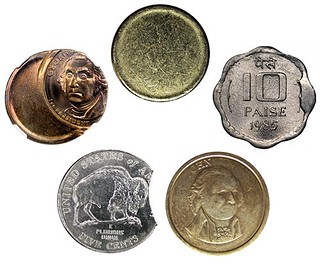 My daily assortment of emails contains quite a few inquiries about rare coins and coin collecting. People run across a news article, or something I have written about,
and think they might have something of value. Over the years, some amazing things have surfaced, and I am careful to respond to every correspondence. My recently purchased hoard
of 13,000 Morgan silver dollars started with such an email. The "Antiques Roadshow" aspect of what I do for a living makes every day potentially exciting!
My daily assortment of emails contains quite a few inquiries about rare coins and coin collecting. People run across a news article, or something I have written about,
and think they might have something of value. Over the years, some amazing things have surfaced, and I am careful to respond to every correspondence. My recently purchased hoard
of 13,000 Morgan silver dollars started with such an email. The "Antiques Roadshow" aspect of what I do for a living makes every day potentially exciting!
Unfortunately, however, about 90% of the emails I receive are from people who think they might have a rare coin, and it is my job to disappoint them. One of the most frequent inquiries is about the much-misunderstood subject of mint errors.
To read the complete article, see:
Jeff Garrett: Collecting Error Coins (https://www.ngccoin.com/news/article/7871/)
The Curse of the Ship of Gold
Pablo Hoffman passed along this new article about Tommy Thompson and the SS Central America. He writes, "This is the most detailed and engrossing version I've seen of this spectacular story." -Editor
How a brilliant scientist went from discovering a mother lode of treasure at the bottom of the sea to fleeing from authorities with suitcases full of cash.
To read the complete article, see:
The Curse of the Ship of Gold (https://narratively.com/the-curse-of-the-ship-of-gold/)
FEATURED WEB PAGE: MILITARY MEDALS OF AMERICA
This week's Featured Web Site is about the important military medals of America.If you've ever walked by a service member wearing their full dress uniform, chances are you've wondered what the colorful ribbons or medals on their jacket mean.
There are literally hundreds of military awards and decorations – each with their own significance, criteria and history – across all of the different branches of the U.S. military. Although some of these awards are easier to identify than others, here are six important medals of America that you can easily spot with a quick glance...

https://www.uso.org/stories/2517-military-medals-of-america

